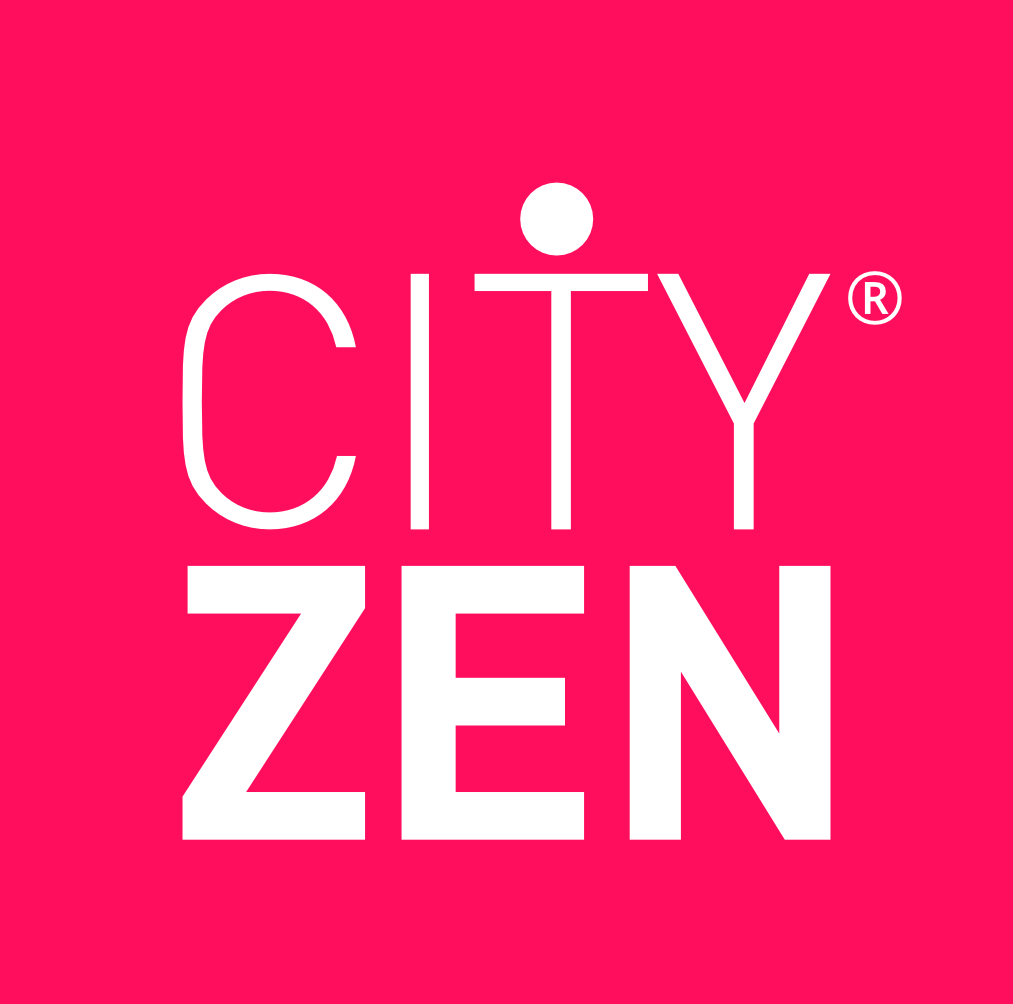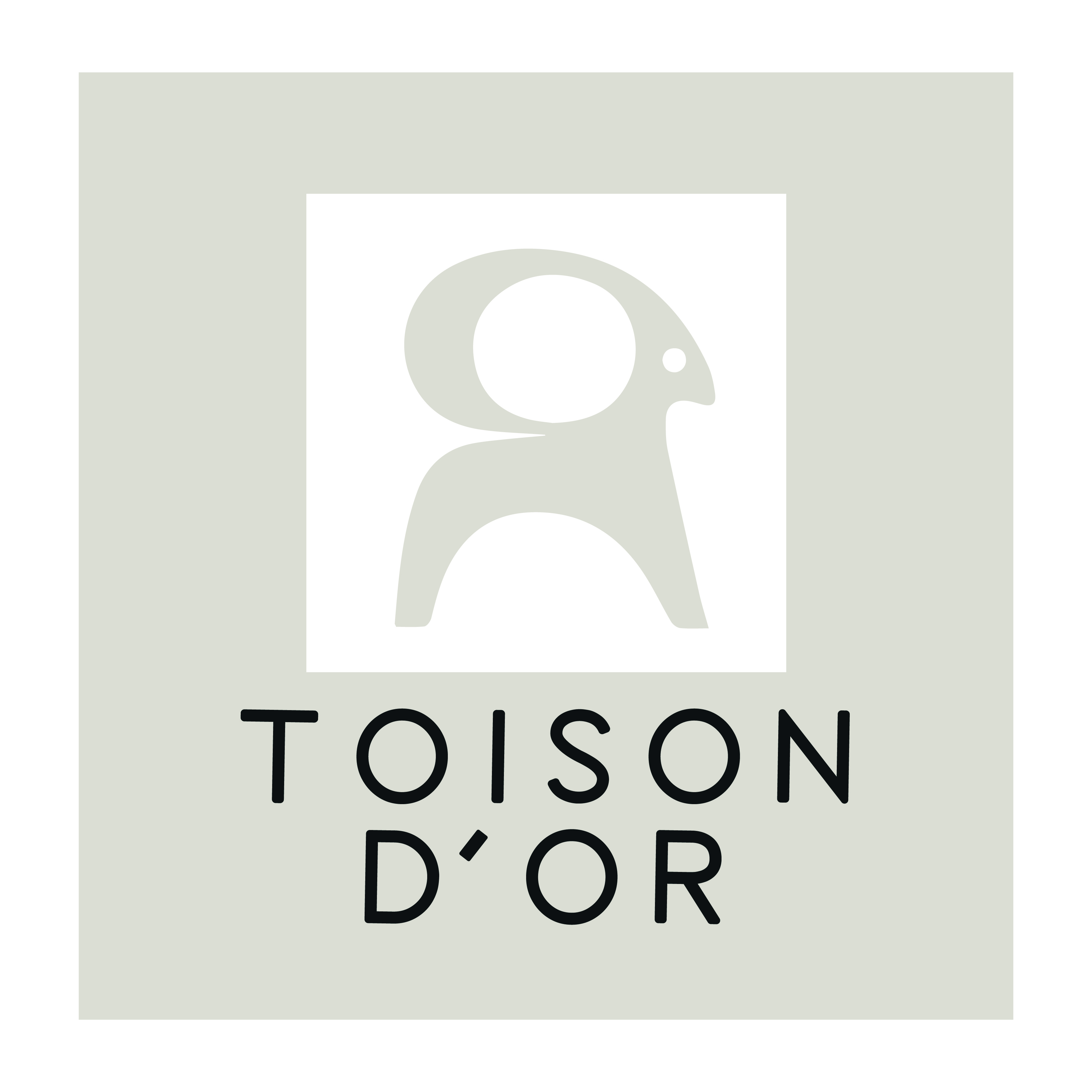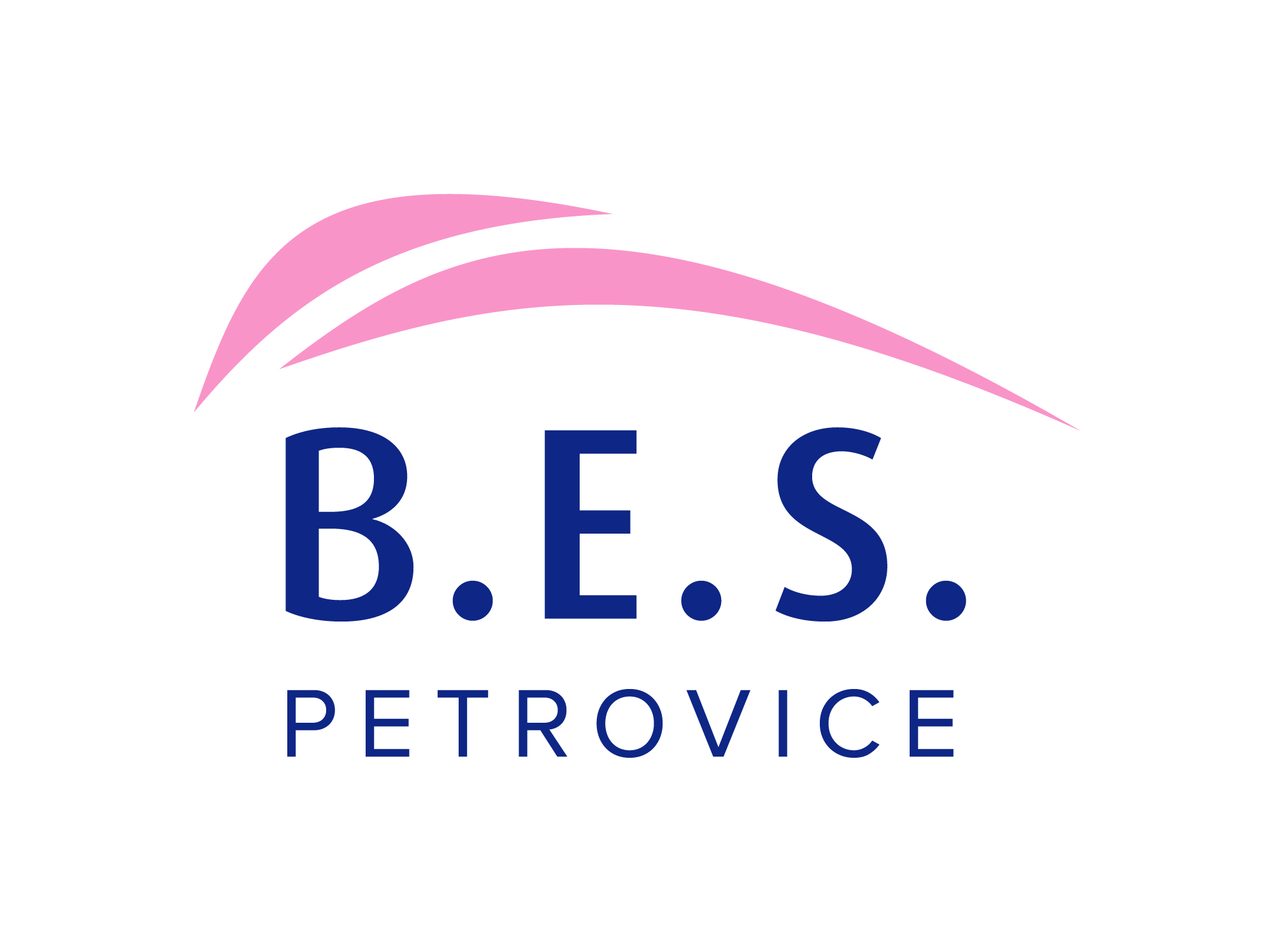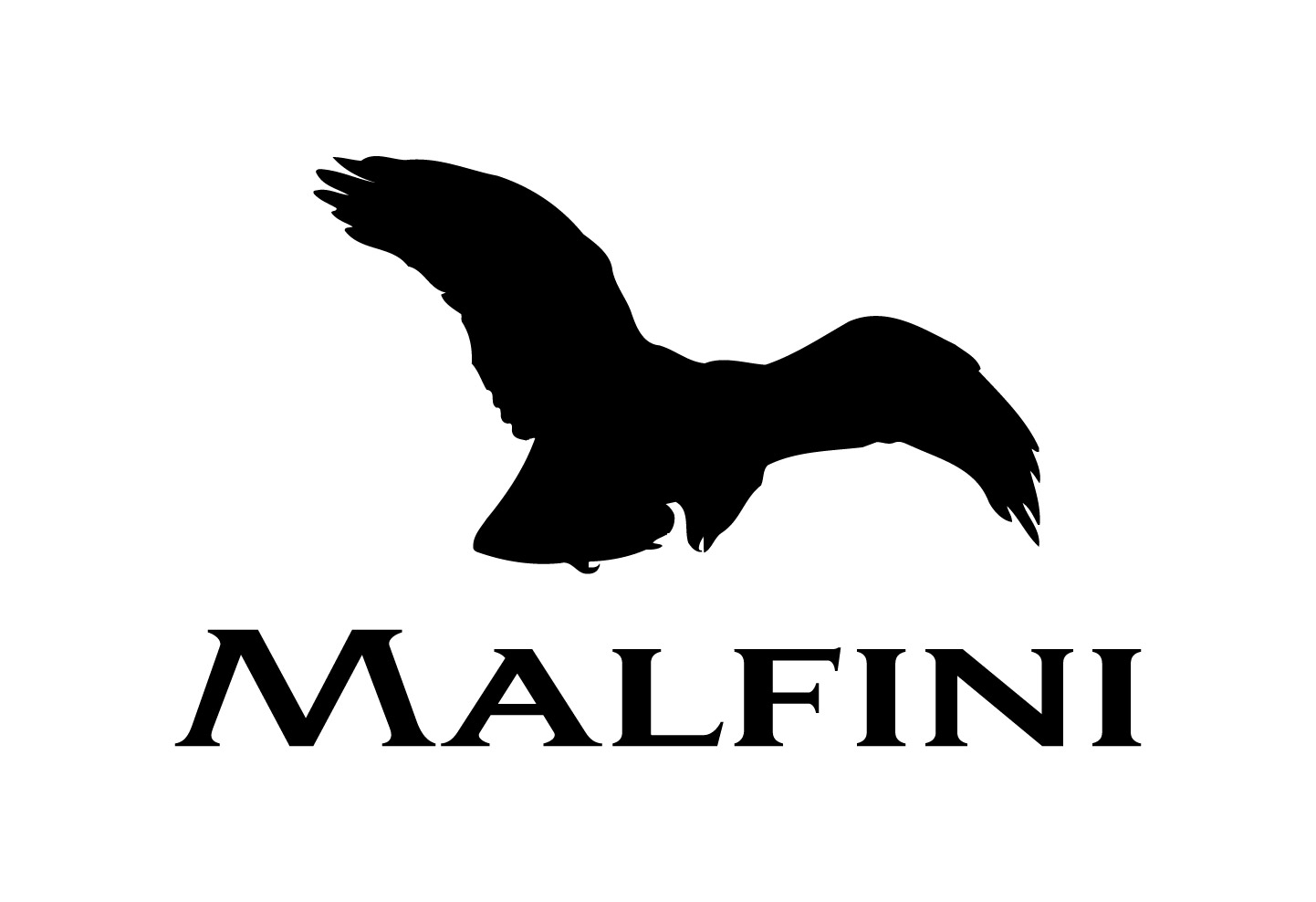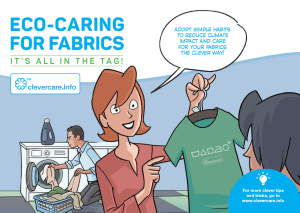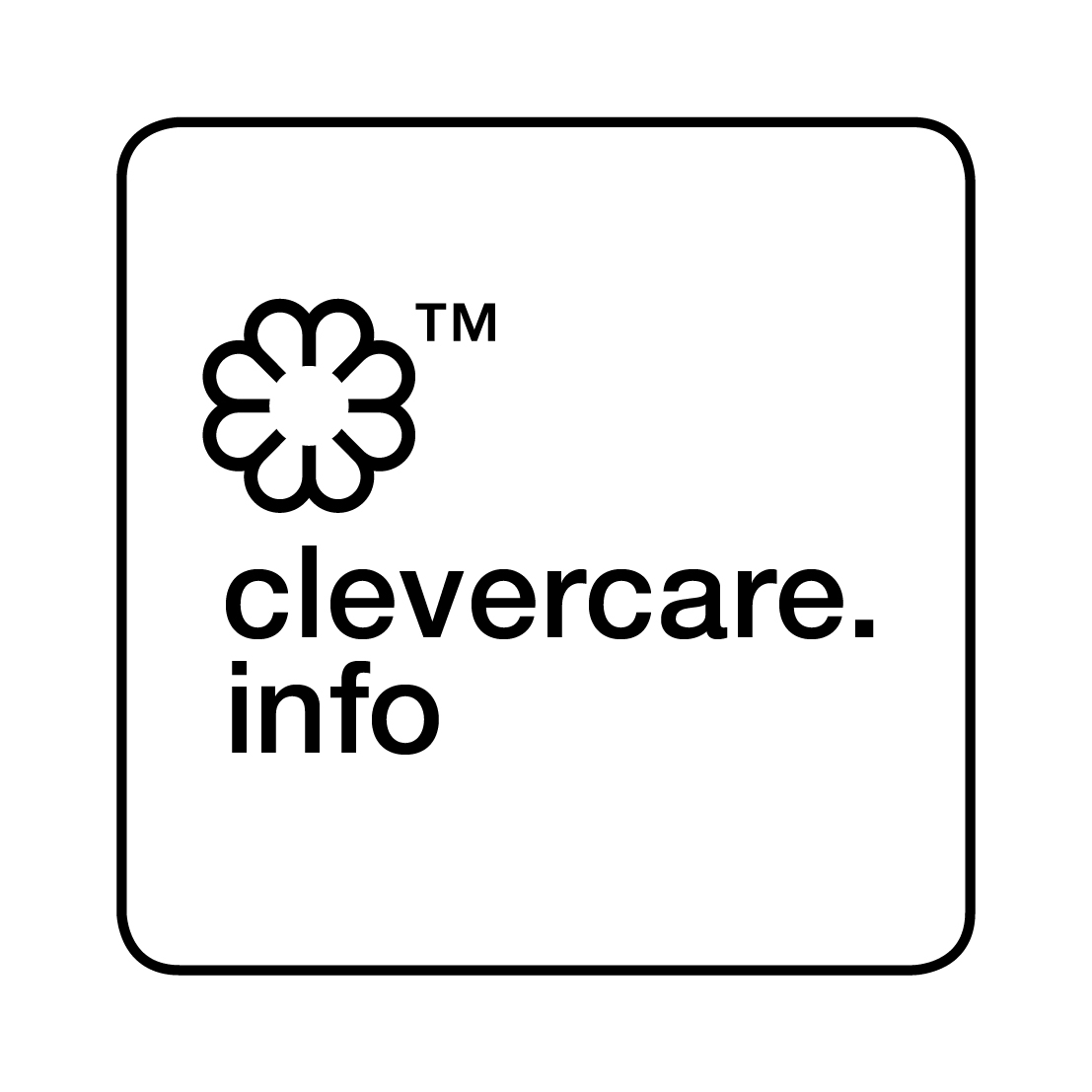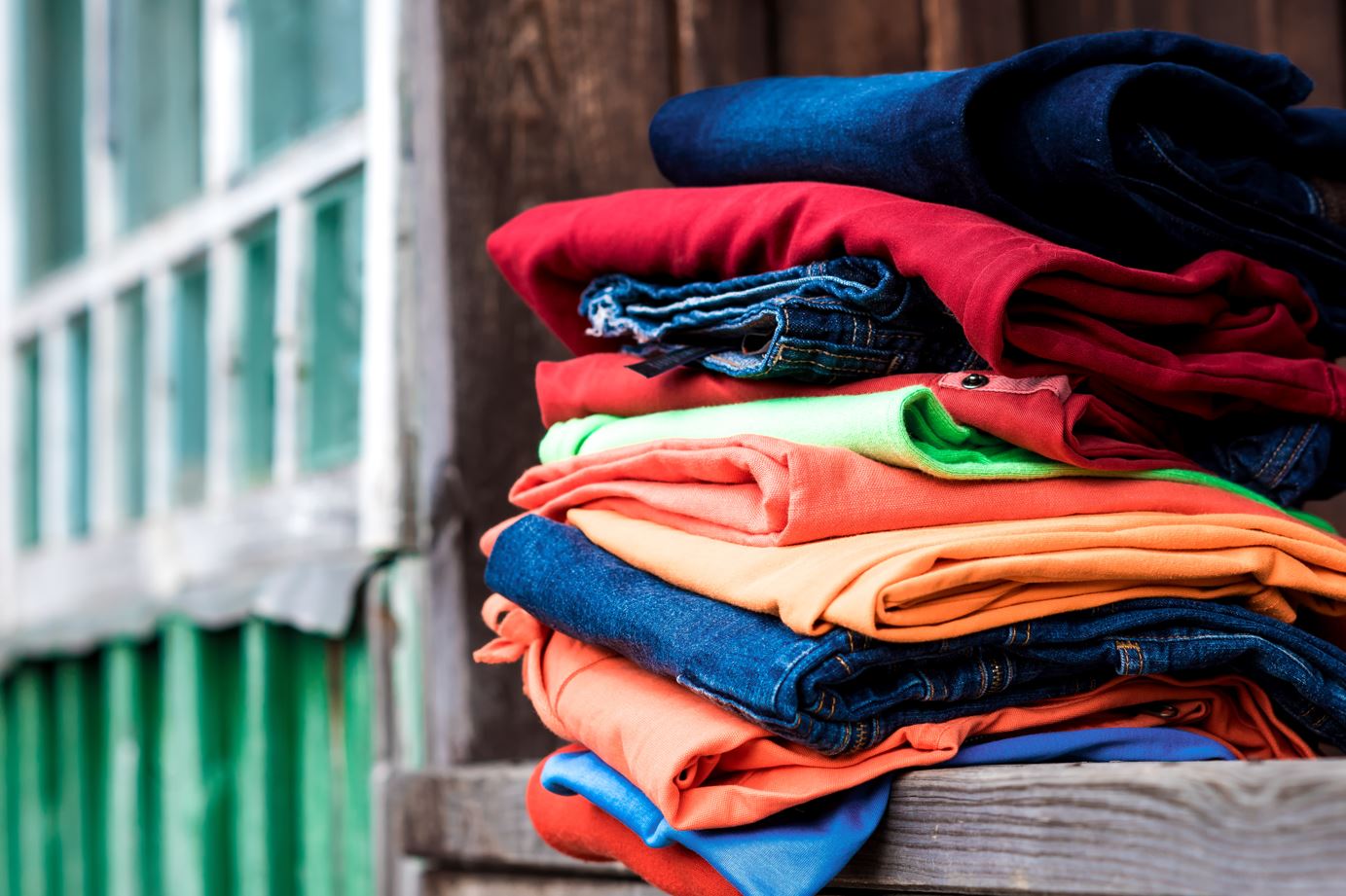A barometer for Textile care labelling in Europe
IN PARTNERSHIP WITH IPSOS, GINETEX PRESENTS THE OUTCOMES OF ITS EUROPEAN BAROMETER: "EUROPEANS AND TEXTILE CARE LABELLING"
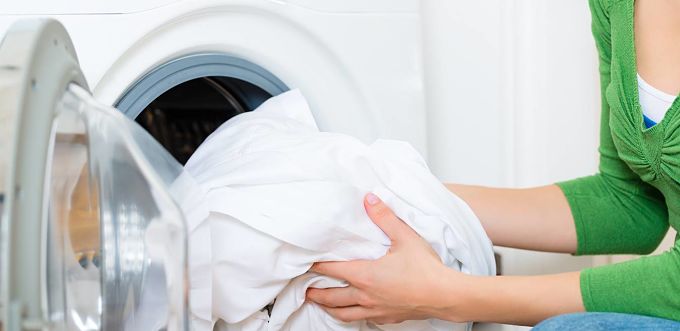
70% of Europeans follow the textile care instructions featured on the labels and
80% admit that they would not (or would rarely) buy clothes without any labels,
While another 84% feel concerned by water and energy savings.
GINETEX, the international Association for Textile Care Labeling, called upon the French market research company IPSOS, to evaluate the behavior of European Consumers with regards to textile product labels and care symbols. This study, carried out in December 2016, combines the results of six different countries, gathered from a sample of 6,000 people in Germany, England, France, Italy, the Czech Republic and Sweden.
This IPSOS study reveals that 70% of Europeans follow the textile care instructions represented by the symbols. At a pan-European level, 57% even admit that they follow them 'often' and 13% do so 'always'. These figures illustrate the importance of care instructions in the minds of European consumers.
- 38% state that they follow these instructions in order to avoid washing problems such as shrinking, in the first place
- 31% follow them in order to preserve their clothes and keep them longer, as a second reason
Overall, Europeans consider labels as too cumbersome and 62% admit cutting them out: for 74% of them, the labels itch and irritate their skin and for another 55%, they are often too long and uncomfortable. These results can differ from one European country to another.
However, the presence of the label is a real purchasing criterion since 80% of Europeans state that they would never or rarely buy a piece of clothing without a label.
Internet and smartphones: true virtual partners for textile labels
Here's from a positive perspective: when solving a specific washing issue or when faced with symbols that they don't understand, 53% of respondents are curious about their meaning and automatically look them up on the Internet: 39% use a computer and 21% use their smartphone.
Ironing and washing symbols are the most recognized by Europeans!
The study reveals that the ironing and washing symbols are the ones that are best understood by our neighbors: scoring respectively 97% and 91%.
|
The three other symbols remain unclear to consumers:
The same is true for special features such as underscores under the symbols, noticed by only 1 out of 4 Europeans.
|
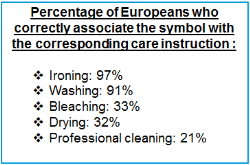 |
Eco-care, a major issue for European consumers!
The IPSOS study reveals that 84% of Europeans feel concerned about water and energy savings. And among Europeans who feel concerned, 90% take specific eco-actions when caring for their textile products.
It is worth mentioning that European consumers already seem to adopt the proper eco-habits when caring for their textiles.
- 62% choose "natural drying as soon as possible"
- 61% do "mainly low temperature washes"
- 44% use the "Eco program"
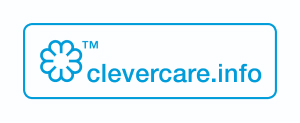
GINETEX values eco-caring for textiles, in particular via its clevercare.info logo, already used by a number of major international brands, in addition to the 5 textile-care symbols. With its own site dedicated to the general public, this logo's objective is to raise awareness and to inform consumers about the simple and easy actions to adopt for textile eco-caring.
"The results of this GINETEX-IPSOS barometer are positive and encouraging. They reflect the fundamental role of GINETEX and that of our international committees who work to increase the understanding of textile care symbols. Our mission is to work on a long-term basis - an effort also confronted with obstacles such as the misinterpretation of symbols and the removal of labels. Together with our member brands, we must continue to reinforce our actions with the general public to ensure all our symbols (and special features) are understood by all, throughout the world. Our permanent goal of standardizing and harmonizing our textile care labeling system worldwide contributes to this improvement every day", says Adam Mansell, President of GINETEX.
Study Methodology:
In this study, a sample of 6,000 people from Ipsos' Online Access Panel, aged between 18 and 65 and representative of the European population was surveyed for the following countries: Germany, Great Britain, France, Italy, the Czech Republic and Sweden. The survey was conducted online in December 2016.
About GINETEX
GINETEX, the International Association for Textile Care Labelling, was first founded in Paris in 1963 following several international Symposiums for Textile Care Labelling at the end of the 1950’s. GINETEX has devised an internationally applicable care labelling system for textiles based on symbols. The pictograms used are registered trademarks and are the GINETEX property. The care labelling system gives consumers and textile companies the correct information on the care treatment of textile products. The processes indicated by the symbols will avoid any irreversible damage to the product. GINETEX is composed by 22 national organisation members. These organisations represent all interested parties concerned with textile care and labelling.
GINETEX Contact
Pascale FLORANT
Secretary General
+33 (0)1 47 56 31 71
A NEW PRESIDENT FOR GINETEX
Thomas Lange appointed President of GINETEX
Paris, November 14, 2022. GINETEX, the International Group for Textile Care Labelling, is pleased to announce the appointment of its new President, Thomas Lange, 59 years old. Elected unanimously at the General Assembly held on November 8, 2022, in Barcelona, his appointment will take effect on January 1, 2023. He succeeds Alejandro Laquidain who will become Vice-President of GINETEX.
Lawyer at the bar of the city of Cologne since 1994, Thomas Lange joined the professional association GermanFashion in 2003, as Managing Director, and later became its CEO in 2018. More specifically, Thomas Lange provides legal advice on matters pertaining distribution rights, national and international contracts, sales of goods and textile labelling obligations. He has a strong expertise in regulatory issues on product safety linked to the marketing requirements of protective clothing on the European market.
A law graduate from the University of Münster, Thomas Lange is the author of "Commentary on the European Textile Regulation”, a reference publication for regulatory issues on textile product labelling. He also holds speeches on product safety issues and on the legal aspects of manufacturers’ liabilities, at conferences and seminars for fashion industry professionals, especially.
“I am honored to continue the remarkable work of my predecessors. The textile industry is particularly concerned by sustainability issues, as I have witnessed in my role as CEO of GermanFashion, the association representing German fashion companies. GINETEX is making great strides on these issues, particularly through its clevercare.info initiative and its MY CARE LABEL application, but also more recently, with its study on energy savings in textile washing programs. I look forward to continuing this work over the next two years as President of GINETEX,” says Thomas Lange.
About GINETEX
First founded in Paris, in 1963, GINETEX, the International Association for Textile Care Labelling, has devised an internationally applicable care labelling system for textiles based on symbols, which aims at informing textile companies and consumers on the best way to care for their textiles. The pictograms used are registered trademarks and are property of GINETEX and COFREET in equal parts. GINETEX promotes these symbols worldwide and coordinates its technical contents on a global scale - which is essential for the definition and application of the care labelling code. Today, GINETEX counts 23 member-countries.
Press Contact
MAARC Agency
Victoria Bareille – victoria.bareille@maarc.fr – +33 (0)1 86 95 41 95
GINETEX Contact
Pascale FLORANT – Secretary General – +33 (0)1 47 56 31 71
www.ginetex.com | www.clevercare.info
MY CARE LABEL (available on App store and Google Play)
Tags : Care
ACT UK: a groundbreaking initiative by UK Fashion and Textile (UKFT) for Advanced Textile Circularity
ACT UK is a two-year initiative which aims to create the blueprint for an Advanced Textile Sorting and Pre-processing (ATSP) facility that will process non-rewearable textiles and enable fibre-to-fibre recycling at a scale. The initiative gathers recycling technologists, textile manufacturers, brands and retailers, collectors and sorters, academic and industry players, with funding from Innovate UK.
The project has recently launched two trials for post-consumer textile collection in car parks and by post mail to encourage the public to sort their used textiles into rewearable and non-rewearable categories. These are part of a series of experiments that will give valuable insights to optimise post-consumer textile collections and redefine the flows of non-rewearable textiles towards a more sustainable textile economy.
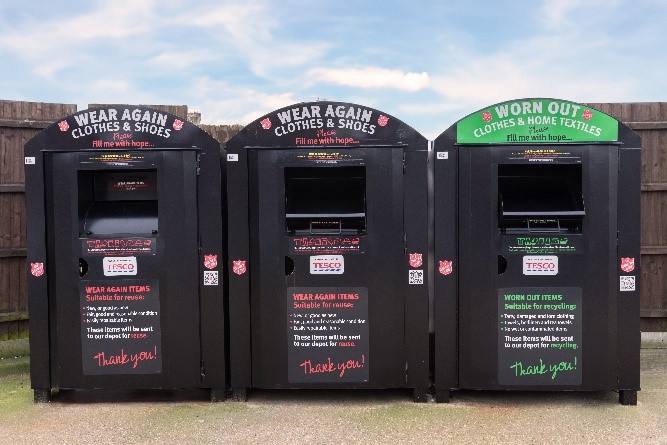
The first experiment is with supermarket chain Tesco and Salvation Army Trading Company (SATCoL), the Salvation Army’s trading division. Individuals can donate their used textiles at 18 Tesco car parks and 2 household waste recycling centres in the East of England. The donation points have separate recycling banks for rewearable and non-rewearable clothing and textiles.
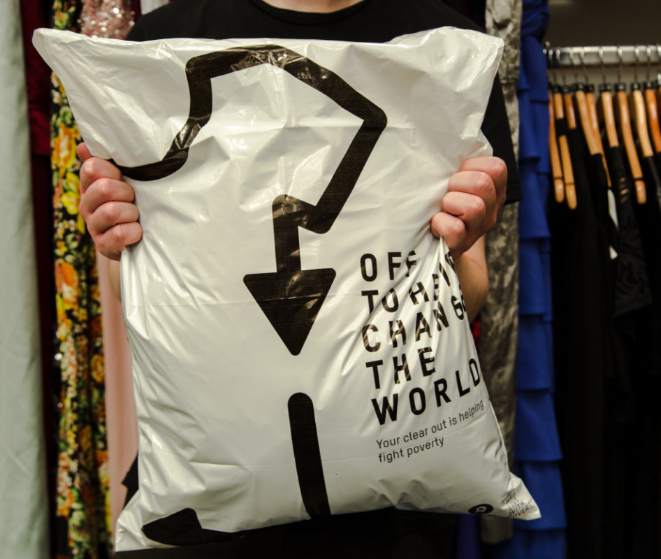
The second experiment is with retailer Marks & Spencer and
charity Oxfam using postal donations. Customers can order an Oxfam postal bag and use a free postal service to donate both rewearable and non-rewearable clothes. For more information on the ACT UK textile collection trials, visit www.acttakeback.org.
ACT UK is investigating the technology and challenges related to large-volume sorting and pre-processing of non-rewearable textiles. The project team has interviewed technology providers and key stakeholders to gather insights on available equipment and developing technologies that could satisfy the requirements of a future Automated Textile Sorting and Pre-processing facility (ATSP). A new report “Automatic-sorting for Circular Textiles, Technology Market Review” by the Manufacturing Technology Centre (MTC) focuses on the key process areas: Fibre Identification & Sorting, Conveyance, Size Reduction and Disruptor Removal.
The project is also providing a proof of concept for a ‘Circular Textiles Ecosystem’ and outlining how a supply chain for non-rewearable post-consumer textiles into fibre-to-fibre recycling processes could work in the UK.
This involves analysing current and future scenarios of non-rewearable textile flows in the UK, including their socio-economic and environmental impacts. Trials will be run where textiles will be taken through the ATSP steps and prepared as feedstock for textile recycling systems, to be recycled into new fibre and yarn.
Find out more here https://ukft.org/innovation/act-uk/
Tags : Care
Adam Mansell appointed as GINETEX President
Adam Mansell appointed as GINETEX President
Adam Mansell, CEO of the UK Fashion and Textile Association (UKFT),
is replacing Thomas Lange.

Paris, 19 November 2024. GINETEX, the International Association for Textile Care Labelling, announced the appointment of its new President, Adam Mansell, at its General Assembly on 8 November 2024. He will take office on 1 January 2025 for a 2-year term up to the end of 2026. He will be succeeding Thomas Lange, who will become Vice-President.
Adam Mansell has led the UKFT (UK Fashion and Textile association) for over eight years. Over his three decades of experience in the segment, Adam has partnered with many professional groups and gained extensive experience throughout the fashion and textile supply chain. He can boast experience in every aspect of this segment, starting with the design process, and including the selection of fabric retailers and suppliers, as well as the distribution and sale of products alongside of wholesalers, brands and manufacturers.
Adam Mansell is also involved in a wide range of groups specialising in the textile industry and holds a seat on several industrial boards at national and international levels. He chairs Future Fashion Factory, an industrial research project worth 5 million GBP, while contributing as a member of the industrial advisory board of the University of Leeds School of Design. In parallel, he also chairs the ACT Recycling Demonstrator project funded by InnovateUK and co-chairs the Circular Fashion Innovation Network. To continue, he is part of the Textile 2030 advisory board and the Institute of Positive Fashion. Furthermore, he also chairs the CapitB charity, which helps companies and individuals involved in the UK fashion and textile industry to fund the development of skill sets and improve training.
“I am thrilled to be appointed President of GINETEX. Textile care labels are critical when it comes to long-term clothing care and more generally in the fashion industry. Suitable labels help to extend the lives of clothing and allow users to get full benefit for as long as possible. Considering the ever-increasing complexity faced by the fashion industry worldwide and the ever-shorter production cycles, it is essential for GINETEX and its members to work closely with their partners throughout the supply chain“, commented Adam Mansell. “I would like to thank Thomas Lange for his remarkable contribution over the last two years. GINETEX recorded significant growth under his leadership. I fully intend to follow in his footsteps by incorporating new countries into our organisation and setting up partnerships with international retailers and brands. With this in mind, our aim is to set up a simple and affordable care labelling system which could be adopted around the world.”
About GINETEX
Established in Paris in 1963, GINETEX (International Association for Textile Care Labelling) is behind an international textile care labelling system designed to inform textile companies, as well as consumers, about the best ways to care for their textile garments. The care symbols used are equally registered trademarks of GINETEX and COFREET. The group promotes these symbols and coordinates its technical content, which is essential for the definition and application of the care labelling code, at international level. GINETEX currently has 21 member countries.
Press contacts
MAARC Agency
Adrien Jibidar – adrien.jibidar@maarc.fr – +33 (0)6 95 46 31 43
Ando Razakarisoa – ando.razakarisoa@maarc.fr – +33 (0)9 72 22 00 68
GINETEX contact
Pascale Florant – Secretary General - +33 (0)1 47 56 31 71
www.ginetex.net | www.clevercare.info
MY CARE LABEL app (available from the App store and Google Play)
Tags : Care
AUGUST 2024

Newsletter n°28
The European Textile Labelling Regulation REGULATION (TLR)
now being revised.
Tags : Care
Brexit: impact on textile labelling
The UK will leave the EU Single Market and Customs Union on 1st January 2021

Whilst businesses have had a long time to prepare, this change will have a dramatic effect on every element of United Kingdom (UK)/ European Union (EU) trade. A potential Free Trade Agreement between the UK and the EU will establish whether and which goods will circulate between these two areas on a tariff free basis as well as other issues around border controls.
However, even if there is a Free Trade Agreement between the UK and the EU, it is expected that
- Customs declarations will still be required at the border in both directions;
- ATA Carnets will be required for attending tradeshows;
- Companies will need to protect their design rights in the UK and the EU;
- there will be separate REACH requirements for the EU and the UK;
- and there will be special arrangements for goods moving through Northern Ireland.
If you bring manufactured goods into Great Britain from the EU or EEA and want to place them on the market, you will have new responsibilities. (Please note Great Britain refers to England, Scotland and Wales. Separate requirements apply to Northern Ireland).
Textile care labelling requirements: some will remain the same but some will change.
The following will remain the same
- There will be no change to the requirement to have full fibre content information fixed on the label of the garment. The content of EU regulation 1007/2011 will be passed in to UK law on 1st January, 2021.
- There will be no change to the care labelling requirements. There is no legal requirement to include care information but if you do not include care information, you would be responsible for any damage caused to the garment if the consumer had undertaken a reasonable cleaning process. Remember though that since 2018 the GINETEX symbols have been protected by trademarks in the UK.
- There will be no compulsory origin labelling unless the consumer could be misled as to where a garment was made.
The following are new requirements for products coming in to the UK from the EU
- You must label the goods with your company’s details, including your company’s name and a contact address in the UK as of 1st January 2021. Until 31 December 2022 these details can be on accompanying documentation. After that they will need to be permanently fixed to the product. However, in order to ensure the consumer is not mislead, this could mean that you would also have to include Country of Origin labelling on the garment.
- CE and UKCA Marking
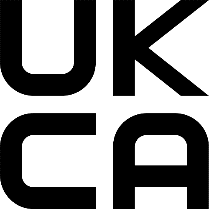
The UKCA mark is a new product marking that will be used in Great Britain (i.e. it does not apply to Northern Ireland). It covers most goods previously covered by the CE mark including toys and PPE.
If you have any question on the impact and requirements in relation to Brexit, GINETEX is at your disposal for any complementary information at ginetex@ginetex.net
Tags : Care
Clevercare.info - A revamped website!
Press release – Paris, September 19, 2023
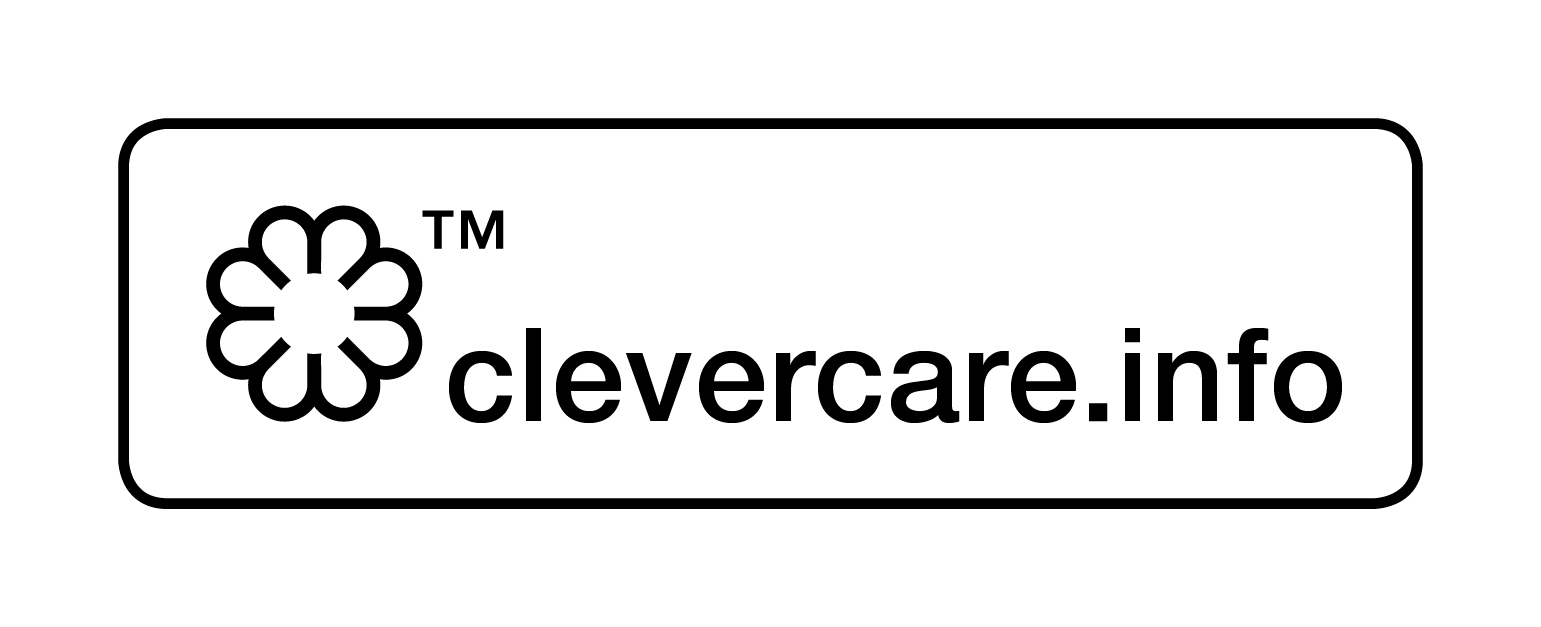
|
Clevercare.info – A revamped website!
Enhanced with new sections, the aim of this new website is to become the reference in textile eco-care for consumers.
|
How we care for our garments represents up to 40% of their environmental impact. With this in mind, the Clevercare.info website created in 2014 by GINETEX - the International Association for Textile Care Labelling - has been further enhanced to offer consumers a new approach to textile care; an essential step to promoting garments’ second life and recycling.
Key information for your textile care routine
With a new look and feel / revamped design, Clevercare.info serves as a real tool to find useful advice and new simple habits to help preserve the quality of your clothes and improve their lifespan - while also saving energy and contributing to the reduction of their environmental footprint.
With its new ergonomics, the website offers smoother navigation, but especially, it is equipped with new sections to help consumers know all about textile eco-care and help them learn how to adopt better laundry practices.
New features include:
|
|
A special search tool to find out how to get rid of a stain on a garment, according to the type of stain and type of textile.
An index of eco-care tips per fabric, with advice on how to wash, dry or iron the garment.
A guide to the textile care symbols on the labels, to understand their meaning - a boost for consumers, given that 73% of Europeans say they follow the care instructions on their labels[1]. |
The way we care for our textiles plays a key part in their sustainability! Not only does textile care help maintain the quality of clothing, it also avoids irreversible damage such as shrinkage or permanent stains that are often responsible for the end of a garment’s life.
"We created Clevercare.info to raise consumer awareness of the benefits of textile care. And this goes far beyond perfectly clean laundry! When consumers take care of their textiles, they act on their garments’ lifecycles - promoting circular economy - and commit to an eco-responsible approach." explains Thomas Lange, President of GINETEX.
How to care for your laundry in a smarter and more environmentally friendly way
Because the smallest changes can create the most impact, clevercare.info delivers 6 simple habits to discover and to use in your daily laundry routine:
|
|
|
Willing to offer the best possible care advice to their consumers, many brands have already joined this initiative to help preserve the quality of their garments, to offer them a second life, or to optimize their recycling.
Available in more than 25 languages, the new Clevercare.info website will be updated with fresh news and tips on a regular basis, thereby enriching the knowledge base for responsible textile care.
|
New website: www.clevercare.info.
|
About GINETEX:
First founded in Paris, in 1963, GINETEX, the International Association for Textile Care Labelling, has devised an internationally applicable care labelling system for textiles based on symbols, which aims at informing textile companies and consumers on the best way to care for their textiles. The pictograms used are registered trademarks and are property of GINETEX and COFREET in equal parts. GINETEX promotes these symbols worldwide and coordinates its technical contents on a global scale - which is essential for the definition and application of the care labelling code. Today, GINETEX counts 22 member-countries.
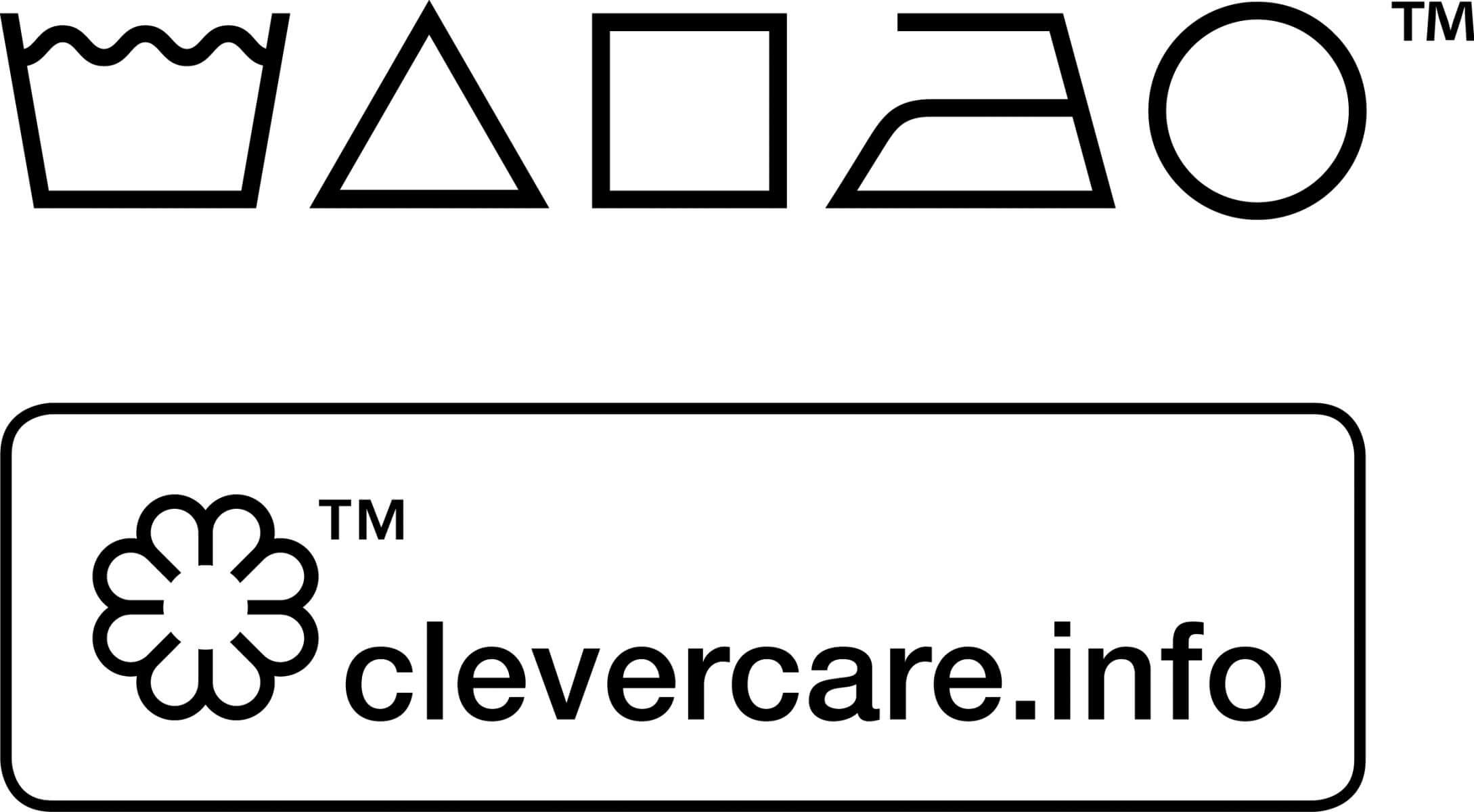
Press contact:
MAARC Agency
Jade SYCHAREUN – jade.sychareun@maarc.fr – + 33(0)6 99 66 13 83
Victoria BAREILLE – victoria.bareille@maarc.fr – +33(0)6 70 73 01 73
GINETEX Contact:
Pascale FLORANT – Secretary General – p.florant@ginetex.net - +33 (0)1 47 56 31 71
Tags : Care
Clevercare.info ambassadors
December 2021

Newsletter n°23
AGEC Law, a new president for IAF, the use of perchloroethylene in France...
Tags : Care
DECEMBER 2022
 Newsletter n°25
Newsletter n°25
LAUNDRY: electricity consumption, GINETEX new board, IAF 37th convention in Bengladesh ...
Tags : Care
DECEMBER 2023
GENERAL PRODUCT SAFETY REGULATION (RSGP)
GENERAL PRODUCT SAFETY REGULATION (RSGP)
From December 13, 2024, the current directive on General Product Safety and the directive on Products Resembling Foodstuffs (87/357/EEC) will be replaced by the new European regulation (EU) 2023/988 of May 10, 2023 on general product safety.
To define the scope of the General Product Safety Regulation, Article 2 states that it applies “to products which are placed on the market or made available on the market.”
Point 2 of Article 2 of the aforementioned regulation sets out a number of exceptions, including:
a) medicinal products for human or veterinary use
b) foodstuffs
c) animal feed
d) live plants and animals, genetically modified organisms, and genetically modified micro-organisms in contained use, and plant and animal products that are directly linked with their reproduction
e) animal by-products and derived products
f) plant protection products
g) equipment on which or in which consumers ride, in order to move or travel, where the operation of such equipment is directly ensured by a service provider as part of a transport service supplied to them, and not by the consumers themselves
h) aircraft as referred to in Article 2(3)(d) of Regulation (EU) 2018/1139
i) antiques
The General Product Safety Regulation states that: “Where products are subject to specific safety requirements imposed by Union law, this Regulation applies only to those aspects and risks or categories of risks which are not covered by those requirements." (Article 2).
This text also reinforces the obligation of marketers in Europe to provide information on: the name, registered trade name or registered trade mark, and contact details, including the postal and electronic address, of the economic operator shall be indicated on the product or on its packaging, the parcel or an accompanying document. (Article 16 3 of the regulations). This information must be clearly and prominently displayed.
Up until now, the current 2001/95/EC directive on general product safety required that “an indication, by means of the product or its packaging, of the identity and details of the producer and the product reference or, where applicable, the batch of products to which it belongs, except where not to give such indication is justified”.
The new text is therefore more precise and, consequently, more demanding. As professionals, you have until December13, 2024 to comply with this new text.
As for distance selling, additional obligations apply for economic players. They are for instance required to provide information which, once again, must be clearly and prominently displayed. This information must mention:
- The name, company name or registered trademark of the manufacturer as well as the postal and e-mail address where they can be can reached.
- When the manufacturer is not based in the European Union, the name, postal address, and e-mail address of the responsible person as defined in Article 16 paragraph 1 of this Regulation or Article 4 paragraph 1 of Regulation (EU) 2019/1020.
- Information enabling to identify the product, including an image of the product, the product type, and any other product identifier.
- Any safety warnings or information that must be affixed to the product or packaging or appear in a complimentary document in accordance with this Regulation or applicable Union harmonization legislation, in a language easily understood by consumers, chosen by the Member State in which the product is made available on the market.
This text is a regulation which means that it is directly applicable - unlike a directive which must be transposed by member states - and will be applicable to all European Union countries from December 13, 2024.
Tags : Care
GINETEX Newsletter
TEXTILE CARE LABELLING NEWS: BE THE FIRST TO KNOW!
Twice a year, GINETEX headquarters issue a newsletter covering textile care labelling information. Learn all about ISO 3758 standard updates, the European Union's latest decisions and on-going projects, international legal and regulation policy updates, GINETEX international partners activities, trademark registration updates, internal GINETEX on-going projects and more!
| Our latest newsletter | Register | Archives |
|---|---|---|
|
catch up on all the latest news |
receive our newsletters for free |
view our previous news topics |
Tags : Care - Symbols - Textile - Europe - News - Regulation - International
Greenwashing: The European Commission proposes a directive on green claims
On March 22, 2023, the European Commission published a proposal for a Directive on the Substantiation and Communication of Explicit Environmental Claims (Green Claims Directive). It presents common criteria to fight greenwashing and misleading environmental claims by providing more specific rules, in addition to a general ban on misleading advertising.
The proposal requires that the validation of explicit environmental claims be based on an assessment that meets a set of minimum selected criteria to avoid that the claims be misleading.
Companies will have to:
- Base their claims on recognized scientific evidences and cutting-edge technical knowledges.
- Demonstrate the significance of impacts, aspects, and performance from a life cycle perspective.
- Consider all significant aspects and impacts to assess performance.
- Demonstrate whether the claim is true for the entire product or only for certain parts of it (for its whole life cycle or only for certain stages, for all the professional's activities or only for parts of it).
- Demonstrate that the claim is not equivalent to the requirements imposed by law.
- Provide information proving that the product is significantly more environmentally efficient than those on the market.
- Determine whether a positive achievement leads to a significant worsening of another impact.
- Transparent reporting of greenhouse gas offsets.
In addition to the substantiation and communication requirements applicable to all claims, Article 8 of the proposal introduces the requirements applicable to environmental labelling, including:
- Requirements for information transparency and accessibility on ownership, on the decision-making body and on the objectives,
- Criteria for awarding labels are to be developed by experts and reviewed by the stakeholders,
- The existence of a complaints and dispute resolution process,
- Procedures for dealing with non-compliance and the possibility of withdrawing or suspending the label in the event of persistent and obvious non-compliance,
- Prohibition of the creation of new national or regional public schemes,
- A validated procedure for environmental labels established by private operators in the EU and third countries by national authorities.
Note that this directive is based on minimum harmonization: it defines minimum requirements as it recognizes that some Member States may sometimes already have a stricter national legislation on the matter. This enables each Member State to set more stringent requirements than those defined in this proposal for a directive.
For more information: ginetex@ginetex.net
Tags : Care
How to clean a fabric face mask in the time of Covid-19
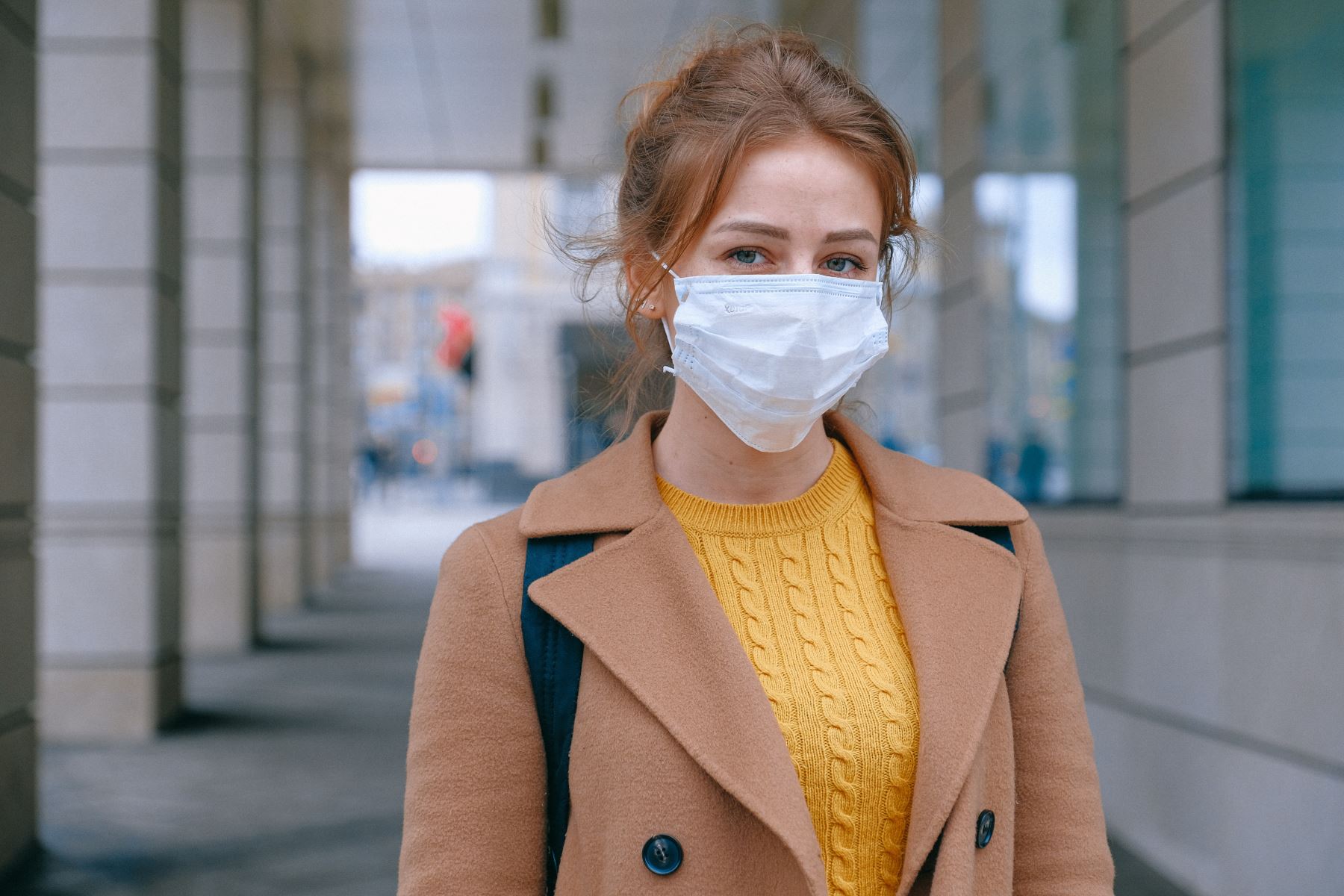
Today, it has become increasingly clear for most of governments and health organisations that, in addition to respecting all social distancing rules, wearing a face mask is key in limiting the propagation of the virus.
As a result, everywhere around the world, we see the production of fabric face masks, both by individuals and textile manufacturers. But how to properly care for your fabric face mask?
Main recommendations on how to wash a fabric face mask
- Wash the fabric face mask before using it for the first time!
- Wash it every time you wear it.
- Be careful when removing it by not letting the mask touch your face, nose, or mouth. You can do so by slipping the elastic bands from your ears or untying the strings.
- Wash your hands before and immediately afterward removing your fabric face mask.
The care instruction recommendations
- Washing - Washing machine programme at 60°C and for at least 30 minutes is required, normal process, with a classic laundry soap.
- Bleaching - Using bleach products, like chlorine and oxygen bleach, may be recommended. However, please note that bleaching may damage faster the mask itself: the colour, the quality of the elastic or the textile material.
- Drying - Mild drying process at 60°C minimum in a dryer (delicate textile).
Or a natural drying in a clean and ventilated area. - Ironing - Iron must be at minimum sole temperature of 110°C, without steam. However, a higher temperature up to 150°C is allowed.
- Professional cleaning - Professional dry cleaning is not allowed. Normal professional wet cleaning process is accepted.
If any, please refer to the care instructions of the textile mask, whether it may withstand the before mentioned care processes. Textile brands could provide their own recommendations on the product, which may vary slightly depending on the composition of the face mask itself and considering national legislations of each country on textile care of face masks.
GINETEX recognizes the textile and apparel industry’s commitment to produce face masks to alleviate the current crisis and will continue to support the industry throughout.
Textile care labelling symbols are a GINETEX registered trademark. Their use by textile and apparel brands requires an annual agreement and contribution to GINETEX.
For more information, contact us
Tags : Care
HOW TO JOIN GINETEX
ALL ORGANIZATIONS, COMPANIES, LABORATORIES, DESIGNERS, COMMUNICATION AGENCIES ETC. CAN BE PART OF OUR WORLDWIDE INITIATIVE

Contacting the GINETEX National Committee in your country
GINETEX is currently composed of 22 country National Members. Each of these National Committees, one per country, is mandated to represent GINETEX and to ensure the correct use of the care symbols in their national territory.
Thanks to GINETEX, national committees can grant the right to companies within their territory to reproduce and use the symbols. The national committees are therefore responsible for care labelling in their own country.
GINETEX created and introduced the system of care symbols in the 1950‘s and has overseen its development eversince. The use of its care symbols is promoted worldwide. The GINETEX Technical Committee meets regularly.
The care symbols are an international trademark owned by GINETEX and registered with the World Intellectual Property Organisation (WIPO). A mandate is given to National Committees, who in turn grant companies within their country the right to reproduce and use the symbols.
GINETEX is an international network. GINETEX membership enhances your professionalism and competitiveness on the market.
Contacting our Head Office in Paris, France
For those countries where GINETEX does not have a National Committee yet, textile and apparel companies are invited to address their willingness to use the GINETEX care labelling symbols by taking direct contact with the GINETEX headquarters in France.
To contact GINETEX in your country,
please refer to the worldwide GINETEX map
Tags : Care - Symbols - Textile - Membership
ISO 3758:2023 standard has been published
JOINT INDUSTRY ANNOUNCEMENT
A.I.S.E., APPLIA & GINETEX TIPS CAN TAKE THE HIDDEN LAUNDRY MASTER OUT OF YOU
Press Release – 5th June, 2018
Three industry associations, representing home appliances, detergents and the textile care sector, are determined to help consumers save water, reduce CO2 emissions and their monthly bills.
By publishing a set of common tips on how to make the best use of a washing machine and laundry detergents while keeping their favourite clothes as new, the organisations guide users for sustainable laundering, from the moment they buy an appliance to the disposal of their empty detergent packaging.
Following up on latest consumer research studies, 2 out of 10 Europeans still do not fully load their washing machine and, only a bit more than half of the consumers (57%) claim they add the correct amount of detergent (A.I.S.E., 2017) and 30% of Europeans still do not follow the textile care instructions, but 80% admit they would not buy clothes without any labels (GINETEX 2017).
“By working on this together, we believe that we will be stronger in helping consumers making small changes to their daily habits. Did you know that in Europe, more than 1000 washes are started every second? Consumers can wash confidently most of their clothes at low temperatures whilst saving energy, CO2 and money. Such small habits changes can make a big difference, reduce the laundry environmental footprint and help fight climate change” said Susanne Zänker, A.I.S.E. Director-General.
Paolo Falcioni, Director-General of APPLiA noted: “A number of studies have noticed that consumers often feel confused whether they are doing their laundry in the way they should. For this reason, together with A.I.S.E. and GINETEX, we have decided to give consumers a hand and help them follow a few simple steps that lead to sustainability and bring us closer to a circular society.”
Adam Mansell, President of GINETEX, said: “By changing our day-to-day habits just a little and by following these easy to use tips, all of us will be able to have a direct, positive, impact on the environment, help our textiles last longer and save money. This common initiative between A.I.S.E., APPLiA and GINETEX, on European level, shows the importance of joining our efforts around sustainable textile laundry for the benefits of our common consumers, our brand members and the planet.”
The short and clear list of tips underlines the need to pay attention to the energy class when choosing an appliance, advises to wash clothes at a low temperature, load machines appropriately, pay attention to textile care labels, use the right dosage of detergent and a lot more.
Read the laundry master tips and tricks
A.I.S.E. – the International Association for Soaps, Detergents and Maintenance products - www.aise.eu
APPLiA – representing home appliance manufacturers from across Europe - www.applia-europe.eu
GINETEX – the International Association for Textile Care Labelling, which has devised an internationally applicable care labelling system for textiles based on symbols - www.ginetex.net
Tags : Care
JULLY 2023

Newsletter n°26
Happy anniversary!
GINETEX has served FOR 60 YEARS responsible textile care for 60 years!
Tags : Care
June 2022
 Newsletter n°24
Newsletter n°24
MY CARE LABEL App, ISO 3758 Standard revision, EU digital product passport...
Tags : Care
LAUNDRY CARE 2024 :
Laundry care - How much power does it take to dry textiles?
GINETEX has revealed the main findings of its recent study on the impact of drying cycles on our power consumption. The study was conducted by Testex, an independent laboratory specialised in textile analysis and certification. This new research follows a preliminary study focused on the same subject dating back to 2022.
- The study shows that the energy consumption of a tumble dryer depends significantly on the spin speed of the washing machine. A ‘standard’ wash cycle is therefore the most effective in limiting a tumble dryer's energy consumption.
- A tumble dryer operating at full load consumes more energy than when it is at 50% of its capacity (or even up to 80%).
- Finally, if the garment remains slightly damp at the end of a programme, this reduces energy consumption by 10 to 30% (or around 0.3 kwh) and makes it easier to iron.
Power consumption is a key concern for households who face both rising energy prices and the cost of inflation on all of their daily expenses. After studying the impact of the different phases of textile washing on power consumption, GINETEX, the International Textile Care Labelling Group, has this time chosen to undertake a similar study focusing dryers.
The study identified significant differences in power consumption depending on spin speeds, fabric types and machine loads.
For more information, read the press release.
Tags : Care
LAUNDRY:
MY CARE LABEL app promoted by SOTEX GINETEX CZ in the in Czech Republic
SOTEX GINETEX CZ, member of the international GINETEX association since 1996, has been promoting textile care symbols in the Czech Republic for decades. The aim is to raise awareness among companies and the public. Among other promotional initiatives, SOTEX GINETEX CZ regularly presents the results of the IPSOS barometer at professional conferences and meetings.
This year, SOTEX decided to put the My Care Label application under the spotlights, which has been available in Czech since February this year. While Czech consumers have a long-term interest in sustainable care and are keen on keeping their products in the best possible condition, many of them still cut their textile labels off, depriving themselves of important information.
SOTEX therefore launched a media campaign to introduce the My Care Label application (Muj štítek in Czech) to the public, explaining its benefits and encouraging consumers to download it. The campaign started on May 20th with a press release and informative articles in trade magazines and on popular portals. This was followed by an advertising campaign via Google Ads and promotion on Facebook.

The campaign focuses on the app’s purpose and how it can help care for textiles on a daily basis. Although the symbols for whitening, drying and professional care are not well known in the Czech Republic, what consumers are most interested in is advice and recommendations. The meaning of the symbols is less important to them.
The number of iOS users in the Czech Republic is low, so the campaign focused on optimisation for Android users, the most popular topics having to do with environmental protection
and proper textile care.
The slogan "Revolution in textile care" proved to be the most successful one and when testing the colour variants of the banners, the blue series attracted the most attention.
“Ad success is higher on Google Ads than on Facebook.
On Facebook, people see the ads but don't download the app.” says Ladislava Zaklová, managing director of SOTEX GINETEX CZ.
Since February, the application has been downloaded approximately 800 times in all countries where it is available, including almost 200 times in the Czech Republic.
“But our work does not stop there. We're constantly monitoring how the app is performing with consumers and developing new content focused on gentle care and spot cleaning, which seems to be the most popular with consumers. We believe that the number of downloads will gradually increase, bringing us closer to our ambitious goals.” Adds Ladislava Zaklová.
For more information, please contact Ladislava Zaklová, managing director of SOTEX GINETEX CZ, z.s.
www.sotex.cz, www.symbolyudrzby.cz
Tags : Care
Results of the 4th IPSOS European barometer 2023
GINETEX BAROMETER 2023: What are the textile care habits in Europe?
GINETEX has unveiled the results of its 4th Barometer for Textile Care, carried out in partnership with IPSOS. This new issue sheds light on the habits of Europeans (Germans, Italians, Spaniards, Swedish, British, Czech and French).
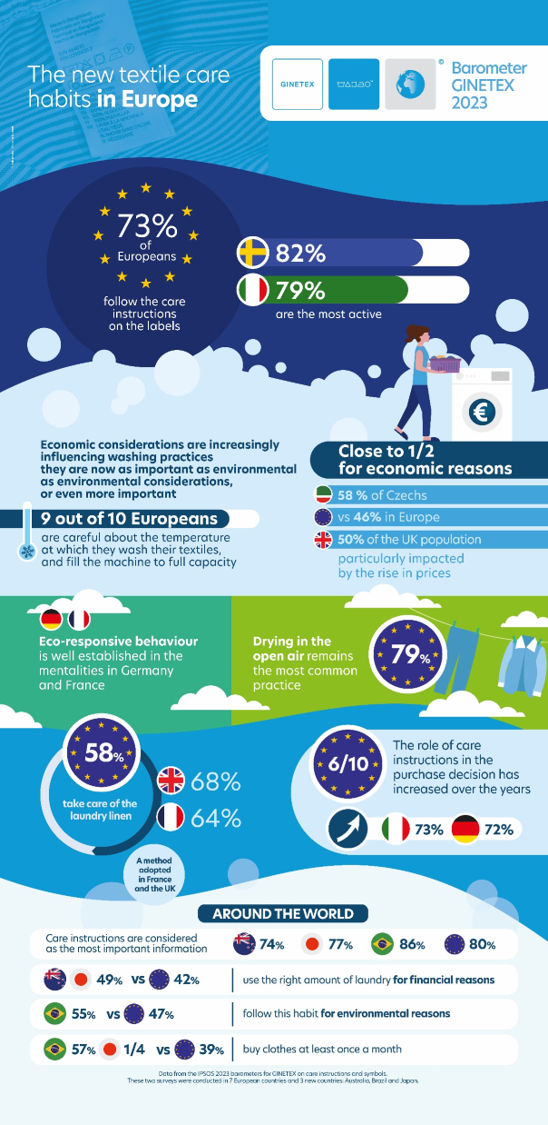
Tags : Care
SUSTAINABLE TEXTILE CARE
CLEVERCARE.INFO, A FULL CONSUMER-ORIENTED MARKETING PROGRAM
© Emmanuel Nguyen
About clevercare.info
Clevercare.info is the GINETEX logo for sustainable textile care, applicable worldwide.
By adopting simple habits, consumers will care for their fabrics the clever way - extending the lifespan of their favourite fabrics while also caring for our planet!
A worldwide communications campaign
GINETEX is currently investing in a worldwide communications campaign to promote its clevercare.info logo. This will benefit its licensee companies worldwide, their consumers and... our planet!
Today, an increasing number of apparel companies agree that consumers are ready to hear from them on how to care for their textiles in order to keep them longer and in better shape, while also taking care of our planet. Consumers are now willing to change their day-to-day habits.
Apparel companies such as Agnes b., Carrefour, Engelbert Strauss Gmbh&Co, Esprit, Galeries Lafayette, Groupe Etam, H&M, Karmameju, KOOKAI, Marimekko, Peak Performance, Playshoes Gmbh, Sevira Kids, Stella Mc Cartney, Ragwear, etc. are adopting the clevercare.info logo on their care labels and strongly believe that textile eco-caring is a priority for our industry today. See all ambassadors
Next year, for their new collections, other companies will also follow this worldwide initiative.
Consumer-oriented communications
GINETEX developed clevercare.info, in order to advise consumers that they can influence the environmental impact of garment care by carefully following the care symbols found on a textile label – www.clevercare.info. The most relevant way in which consumers can reduce the carbon footprint of clothing and textiles in general is to change the way they care for them. Laundry alone accounts for approx. 30% of the carbon footprint of clothing. Fully aware of this market trend, GINETEX licensees are starting to use the logo on their care labels and are developing consumer worldwide communications.
Two GINETEX promotion campaigns are available for external communications. If you are an apparel or textile company, please note that these GINETEX tools can be translated in your national language.
Learn more about the clevercare.info initiative
Watch a 1,45" video spot on Youtube !
See our lively and fun comic strip
If you would like copies, either printed of electronically please contact ginetex@ginetex.net.
Access the website
Tags : Care - Symbols - Textile - Sustainable
SUSTAINABLE TEXTILE CARE
CLEVERCARE.INFO, A FULL CONSUMER-ORIENTED MARKETING PROGRAM
About clevercare.info
Clevercare.info is the GINETEX logo for sustainable textile care, applicable worldwide.
By adopting simple habits, consumers will care for their fabrics the clever way - extending the lifespan of their favourite fabrics while also caring for our planet!
A worldwide communications campaign
GINETEX is currently investing in a worldwide communications campaign to promote its clevercare.info logo. This will benefit its licensee companies worldwide, their consumers and... our planet!
Today, an increasing number of apparel companies agree that consumers are ready to hear from them on how to care for their textiles in order to keep them longer and in better shape, while also taking care of our planet. Consumers are now willing to change their day-to-day habits.
Apparel companies such as Agnes b., Carrefour, Engelbert Strauss Gmbh&Co, Esprit, Galeries Lafayette, Groupe Etam, H&M, Karmameju, KOOKAI, Marimekko, Peak Performance, Playshoes Gmbh, Sevira Kids, Stella Mc Cartney, Ragwear, etc. are adopting the clevercare.info logo on their care labels and strongly believe that textile eco-caring is a priority for our industry today. See all ambassadors
Next year, for their 2018 collections, other companies will also follow this worldwide initiative.
Consumer-oriented communications
GINETEX developed clevercare.info, in order to advise consumers that they can influence the environmental impact of garment care by carefully following the care symbols found on a textile label – www.clevercare.info. The most relevant way in which consumers can reduce the carbon footprint of clothing and textiles in general is to change the way they care for them. Laundry alone accounts for approx. 30% of the carbon footprint of clothing. Fully aware of this market trend, GINETEX licensees are starting to use the logo on their care labels and are developing consumer worldwide communications.
Two GINETEX promotion campaigns are available for external communications. If you are an apparel or textile company, please note that these GINETEX tools can be translated in your national language.
A 1,45" video spot on Youtube !
A lively and fun comic strip
If you would like copies, either printed of electronically please contact ginetex@ginetex.net.
Access the website
Tags : Care - Symbols - Textile - Sustainable - News - International
THE 10th REVISED GHS EDITION NOW RELEASED
THE 10th REVISED GHS EDITION NOW RELEASED
The tenth edition of the Globally Harmonized System of Classification and Labeling of Chemicals, also known as GHS, has been revised and published on the website of the United Nations Economic Commission for Europe.
GHS defines and classifies the different hazards of marketed products and communicates health and safety information using product labels and safety data sheets.
GHS’s mission is to harmonize the criteria for hazard classifications and to standardize the content and format of safety data sheets and labels and that are used worldwide, to ease consumers’ understanding of the risks that are linked to the products.
Concerning the communication of hazards and warning information by means of labels and safety data sheets, the GHS specifies that specific information must be brought to the attention of consumers via a label and safety data sheets (SDS) which contain 16 sections and specific information.
This tenth edition of the GHS includes the amendments that were adopted at the eleventh session of the Committee of Experts on the Transport of Dangerous Goods and on the GHS.
The 10th edition edition of the GHS contains various new or revised provisions addressing:
- The classification procedure for desensitized explosives
- The use of non-animal testing methods for classification of health hazards
- Further rationalization of precautionary statements to improve users’ comprehensibility while taking into account usability for labelling practitioners
- Review of guidance documents on aquatic environment hazards and on the transformation/dissolution of metals and metal compounds in aqueous environments
Building upon this increasingly comprehensive foundation, GHS helps consumers better understand these criteria, while also facilitating trade.
Tags : Care
The Charter for sustainable cleaning
A.I.S.E. presents first products which comply with the renewed detergents industry sustainability standard and relaunched its cleanright.eu platform

A.I.S.E., the International Association for Soaps, Detergents and Maintenance Products, hosted its first symposium on the Charter for Sustainable Cleaning 2020 on 12 February 2020. This event celebrated the appearance of the first products on the market in several countries in Europe, which comply with the renewed detergents industry sustainability standard. These products carry the new Charter marks on pack.
The Charter for Sustainable Cleaning, initiated in 2005, has recently been upgraded to more complete and relevant requirements, and is aligned with the latest EU Green Deal, EU circular economy and plastics policy, climate change priorities and global policy expectations.
A comprehensive scheme tackling production, design and consumption
Companies who sign up to the A.I.S.E. Charter 2020+ commit to continuous improvement both in the manufacturing and in the formulation of their products. Consumer advice to promote safe and sustainable use of products is also provided, making it a very comprehensive sustainability scheme including annual reporting and independent verification. More than 200 companies are signed up to this scheme, representing the vast majority of the detergents and maintenance products market in Europe.
Engaging consumers
From now on, consumers will be able to progressively see products on the shelves with the new marks. Consumers can be assured that products carrying the Charter marks meet high standards for environmental safety, minimise waste and provide clear and transparent information on how to use them safely and in a more sustainable way, without compromising the cleaning performance.
Supporting communication on the Charter and practical tips to help consumers use these products more sustainably can be found on the www.cleanright.eu portal recently relaunched. On this platform, in the laundry room, care labels are covered and tips taken from the clevercare.info initiative are relayed.
For more information
- Download the A.I.S.E. press release
- What is Charter 2020+ in 1 minute: watch the video
- Go to https://www.sustainable-cleaning2020.com/home/what-is-the-charter
- Go to www.cleanright.eu
Tags : Care
The Extended Producer Responsibility (EPR)
AGEC Law: TRIMAN signage and info-sorting
Article L.541-10 of the French Environmental Code provides for the principle of Extended Producer Responsibility (EPR). To fulfil their obligation, companies selling their products in France have an obligation to contribute to waste management via two alternative approaches: (1) To implement an individual waste collection and processing system, or (2) To become a member of an approved eco-organization (e.g.: Refashion for textiles/Citéo for packaging) in France to which they transfer their obligation and pay a financial contribution in return based on sales declaration.
In practice however (when faced with cost, organizational issues, etc.), companies prefer to join and become members of the eco-organization (Re-Fashion/Citéo) to free themselves from their EPR obligation. Most – not to say all - companies choose that solution.
The Unique Identification Number
Article 541-10 of the French Environmental Code provides that all producers that are concerned by EPR must register with the administrative authority (ADEME) and benefit from a unique identification number. This registration guarantees membership in the eco-organization, or the implementation of an individual waste management system. It provides relevant data to monitor and determine the quantitative and qualitative objectives of waste prevention and waste management for the sector.
https://refashion.fr/pro/en/unique-identification-number-uid-how-get-it
How do proceed?
Every producer selling products in France that fall within an EPR scheme (e.g. textiles, packaging) must register with a Producer Responsibility Organization (PRO) relevant to the product categories you carry: Refashion for textiles and Citéo for household packaging.
Refashion: How to get my Unique Identification Number (UID) ?
Citéo: How to get my Unique Identification Number (UID) ?
Contact information:
Refashion
Maketers Hotline
Monday-Friday 9am-6pm
+33 1 89 16 94 06
Citéo
50, Boulevard Haussman 75009 Paris – France
+33 1 81 69 06 00
The TRIMAN logo & info-sorting
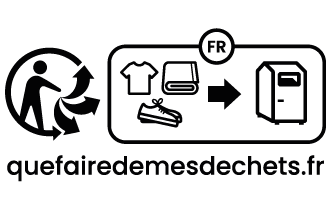
Implementation of the TRIMAN + info-sorting for textile products
Law No. 2020105 on the circular economy and the fight against waste (AGEC Law) issued on February 10, 2020, and imposes from January 1st 2022, the affixing of TRIMAN signage and info-sorting on products such as clothing textiles, household linen and footwear.
The obligation to affix the TRIMAN signage developed by ReFashion applies to all textile products and is therefore not dependent on a membership of the Refashion eco-organization.
Decree No. 2021-835 (June 29, 2021) on consumer information on waste sorting rules for products pertaining to the principle of extended producer responsibility specifies the terms of application of this AGEC law system.
The French Ministry validation on the info-sorting has been given on 31/01/2022 to Refashion. From that date, producers of clothing, household linen and footwear will have a period of 12 months to bring their products into compliance and to label them with the sorting information (the period is extended to 18 months if the products were manufactured before the Ministry's validation date).
Download the Triman Package (EN) - https://refashion.fr/pro/fr/%C3%A9l%C3%A9ments-graphiques
For more information - https://refashion.fr/pro/en/marketer-faqs
Implementing of the TRIMAN + info-sorting for household packaging

The sorting info supplements the Triman signage for household packaging in France, under article 17 of the AGEC law. As of January 1st 2022, and no later than March 9, 2023*, this new harmonized marking must appear on your household packaging if you market products that are intended for households and if your organization is subject to the Extended Producer Responsibility system (EPR). This includes hang-tags, plastic bags, cardboard boxes, etc. which are directly linked to your textile products.
*Note that products manufactured or imported before the validation date (September 31, 2021) benefit from an additional 6-month expiration period.
Citéo is the eco-organization providing mandatory sorting information for household packaging. In order to retrieve this sorting info, you must join the organization online, on their website: https://clients-emballages.citeo.com/fr/public/login/espace-adhesion
For more information, please go to: https://www.citeo.com/ - https://www.citeo.com/info-tri/
Tags : Care
News
GINETEX NEW PRESIDENT – On November 8th 2024, Adam Mansell has been appointed as GINETEX President for a 2-year period starting January1st 2025. He is the CEO of the UK Fashion and Textile Association (UKFT).
ISO 3758:2023 STANDARD HAS BEEN PUBLISHED
December 6th ,2023 – ISO 3758:2023 standard has been published, Textiles – Care labelling code using symbols.
This fourth edition cancels and replaces the third edition (ISO 3758:2012) technically revised.
RESULTS OF THE 4th IPSOS EUROPEAN BAROMETER 2023
What are the textile care habits in Europe ?
A NEW PRESIDENT FOR GINETEX
Mr. Thomas Lange, from German Fashion Association, has been appointed President of GINETEX for 2 years starting 1 January 2023.
RESULTS OF THE 3rd IPSOS EUROPEAN BAROMETER 2021
Environmental concerns are now central to Europeans’ new textile care habits.
BREXIT: IMPACT ON TEXTILE LABELLING
Textile labelling requirements in the UK will change starting 1st January 2021. Here are the main new requirements.
THE CHARTER FOR SUSTAINABLE CLEANING
A.I.S.E. presents first products which comply with the renewed detergents industry sustainability standard and relaunched its cleanright.eu platform.
A NEW PRESIDENT FOR GINETEX
Mr. Alejandro Laquidain, from Consejo Intertextil Español, has been elected President of GINETEX for 2 years starting 1 January 2021.
CLEVERCARE.INFO - A REVAMPED WEBSITE!
Enhanced with new sections, the aim of this new website is to become the reference in textile eco-care for consumers.
RESULTS OF THE 2ND IPSOS EUROPEAN BAROMETER 2019
One of the main findings is that durability of clothing is at the heart of Europeans’ interests, who wish to keep their garments for as long as possible.
HOW TO CLEAN A FABRIC FACE MASK
In the time of Covid-19, GINETEX gives you the main recommendations on how to take care for your fabric face mask.
GINETEX SIGNS THE UN CHARTER
By signing the UN Fashion Industry Charter for Climate Action, we continue our commitment to make consumers and brands aware of the changes necessary to decrease the impact of the textile and Fashion industry on the environment
SUSTAINABLE TEXTILE CARE
Clervercare.info, a full marketing program aimed at end-customers. Discover more with our video and comic strips!
A NEW PARTNERSHIP
GINETEX is now member of the Sustainable Apparel Coalition – Both of our international organizations are teaming up for a better world!
JOINT INDUSTRY ANNOUNCEMENT
A.I.S.E., APPLiA & GINETEX are publishing their joint tips for sustainable laundering.
A BAROMETER FOR CARE LABELLING
GINETEX, in partnership with IPSOS, unveils the outcomes of its European barometer "Europeans and textile care labelling".
THE EXTENDED PRODUCER RESPONSIBILITY (EPR)
France: The AGEC Law imposes, from January 1st 2022, the affixing of TRIMAN signage and info-sorting on products such as clothing textiles, household linen and footwear.
National Members
Video
GINETEX has developed an internationally applicable logo for sustainable care. Consumers are given information to help them reduce the environmental impact of caring for textile.

 Newsletter n°22
Newsletter n°22

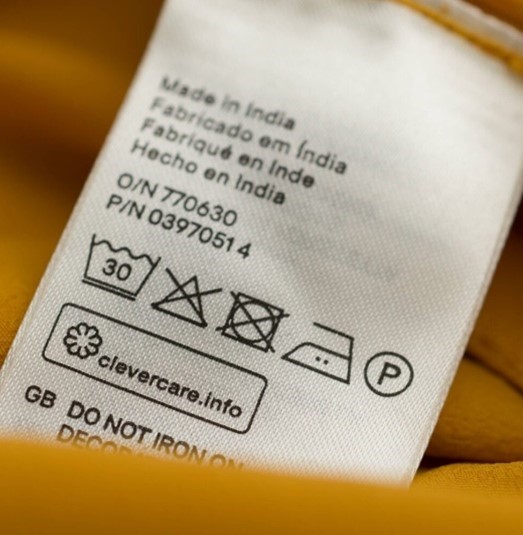
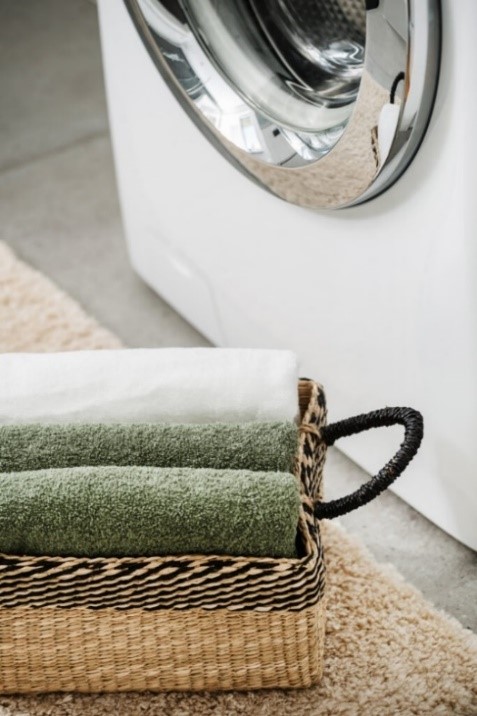

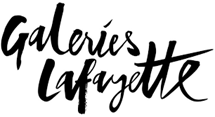
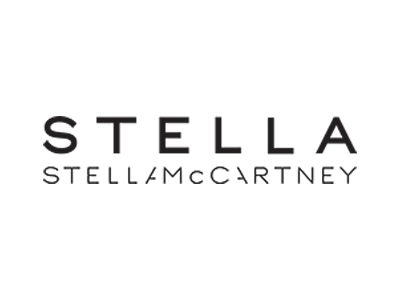
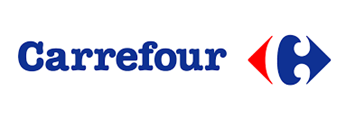

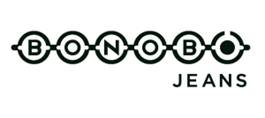
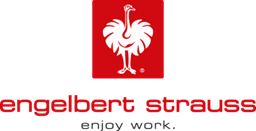


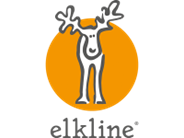
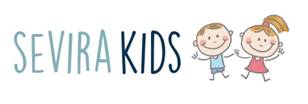



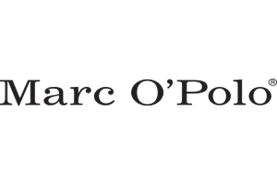
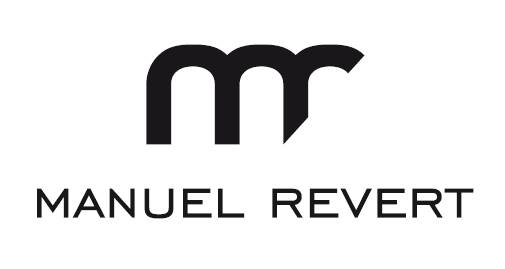
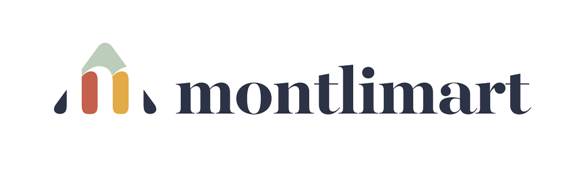
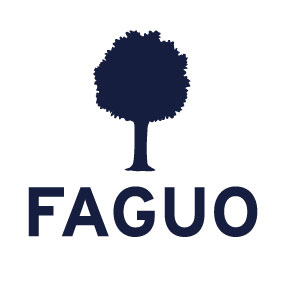
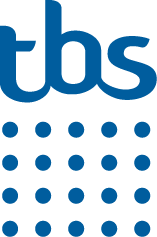
.JPG)
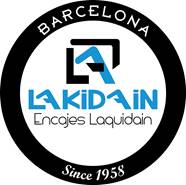
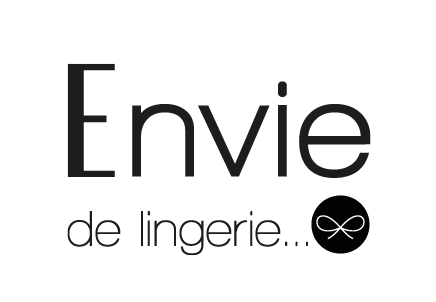

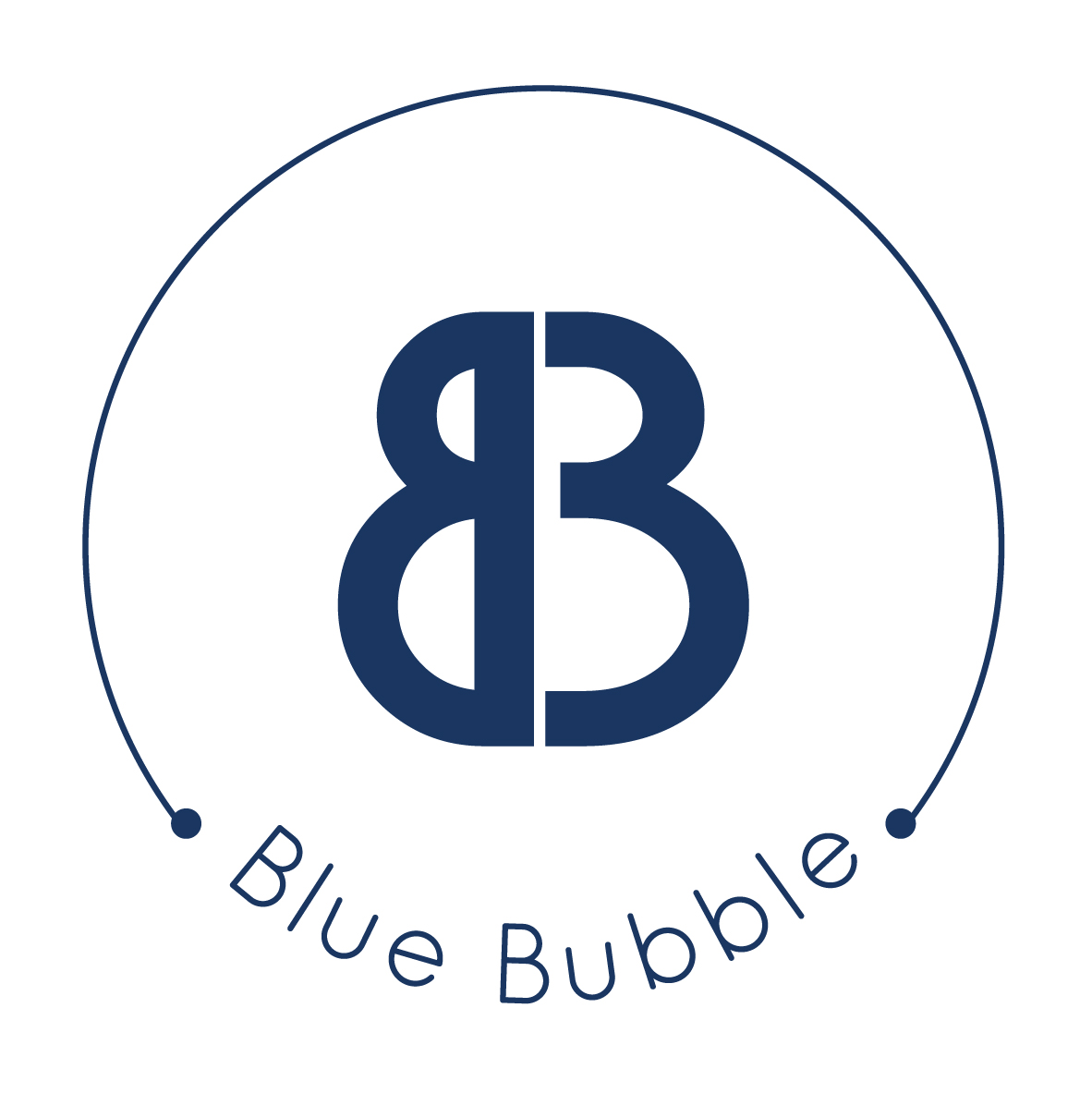


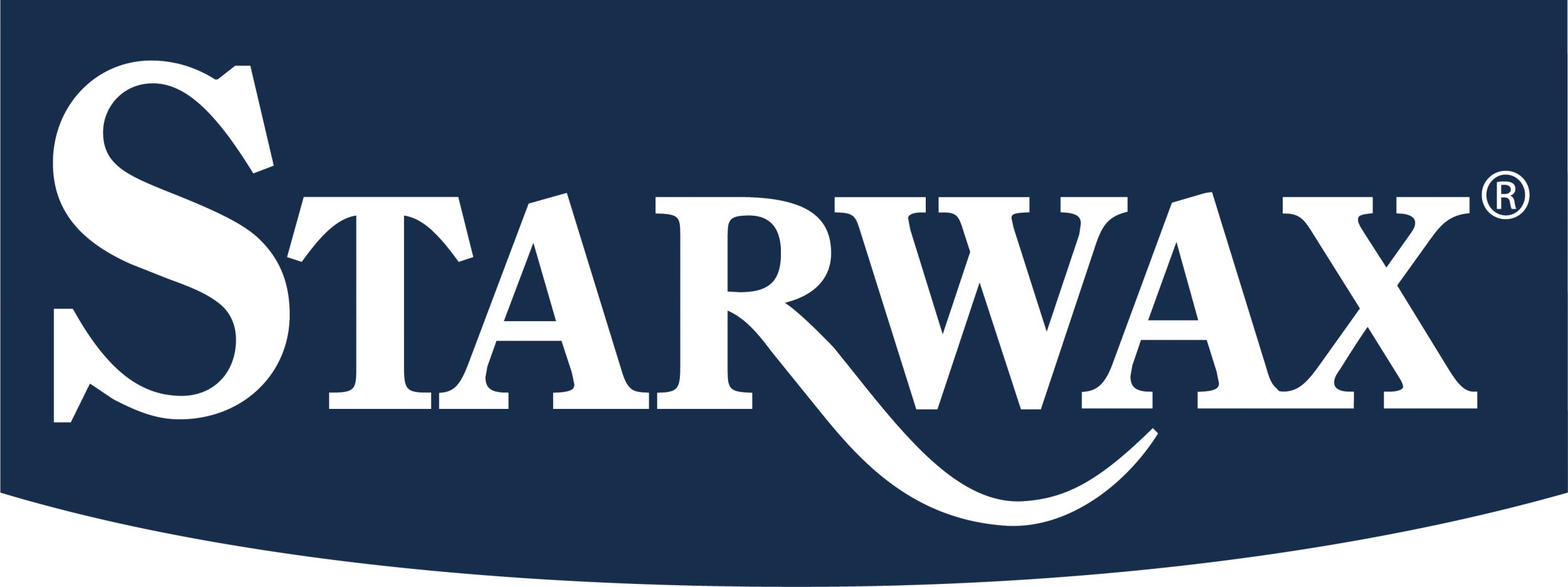
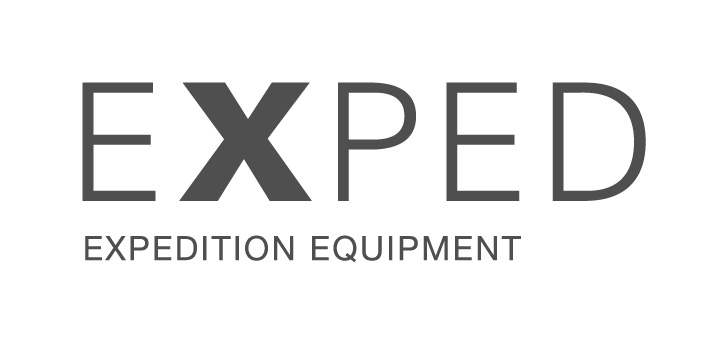

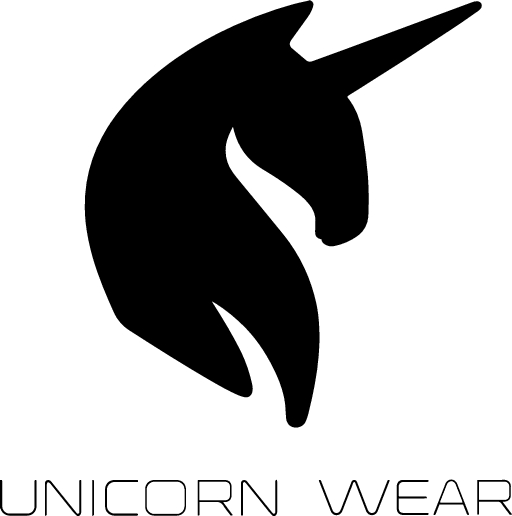
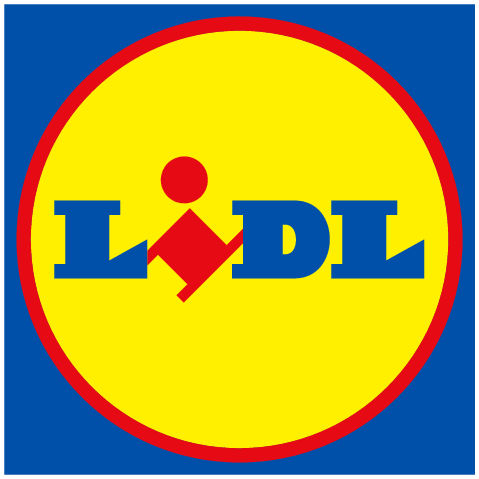

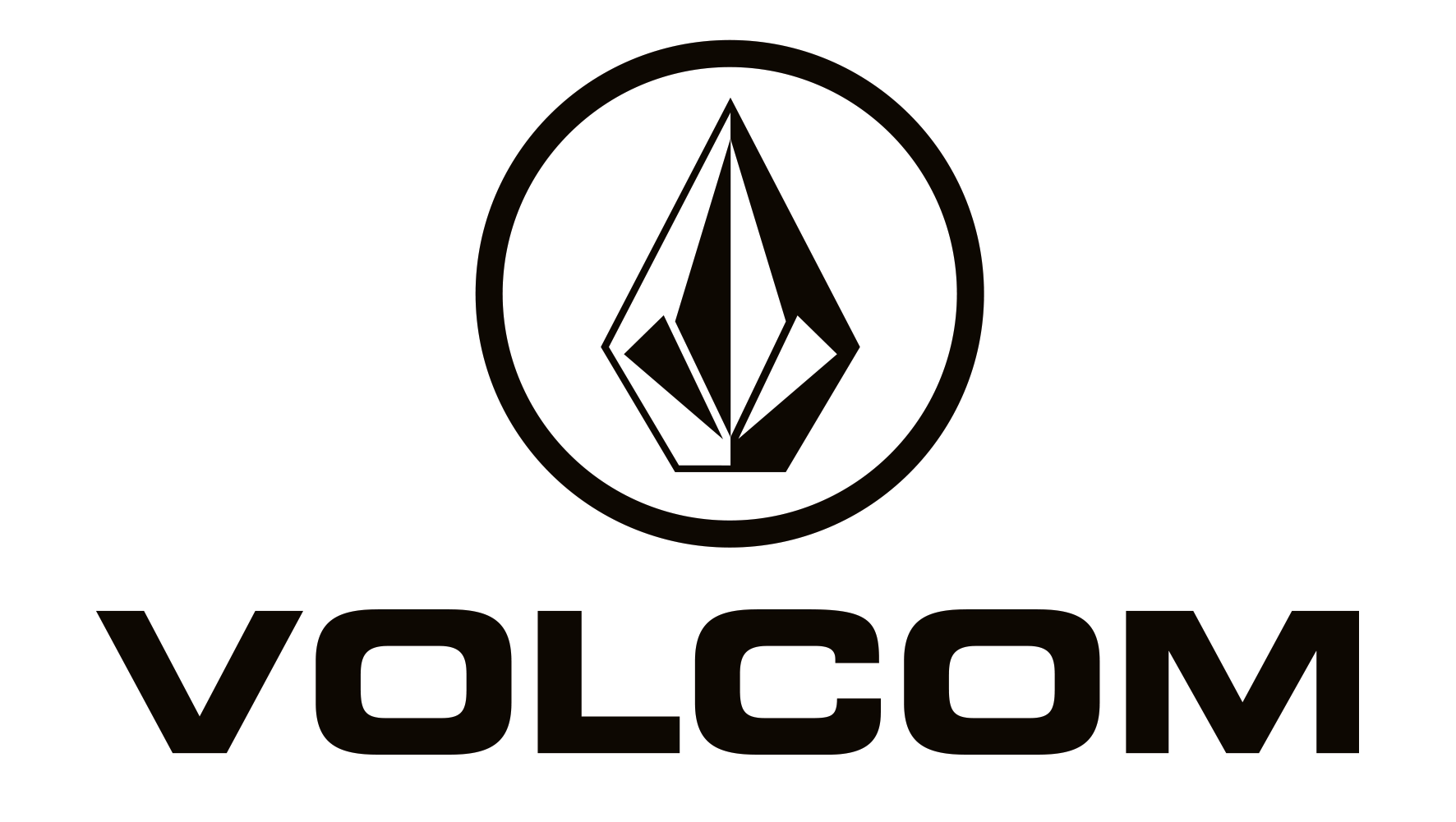
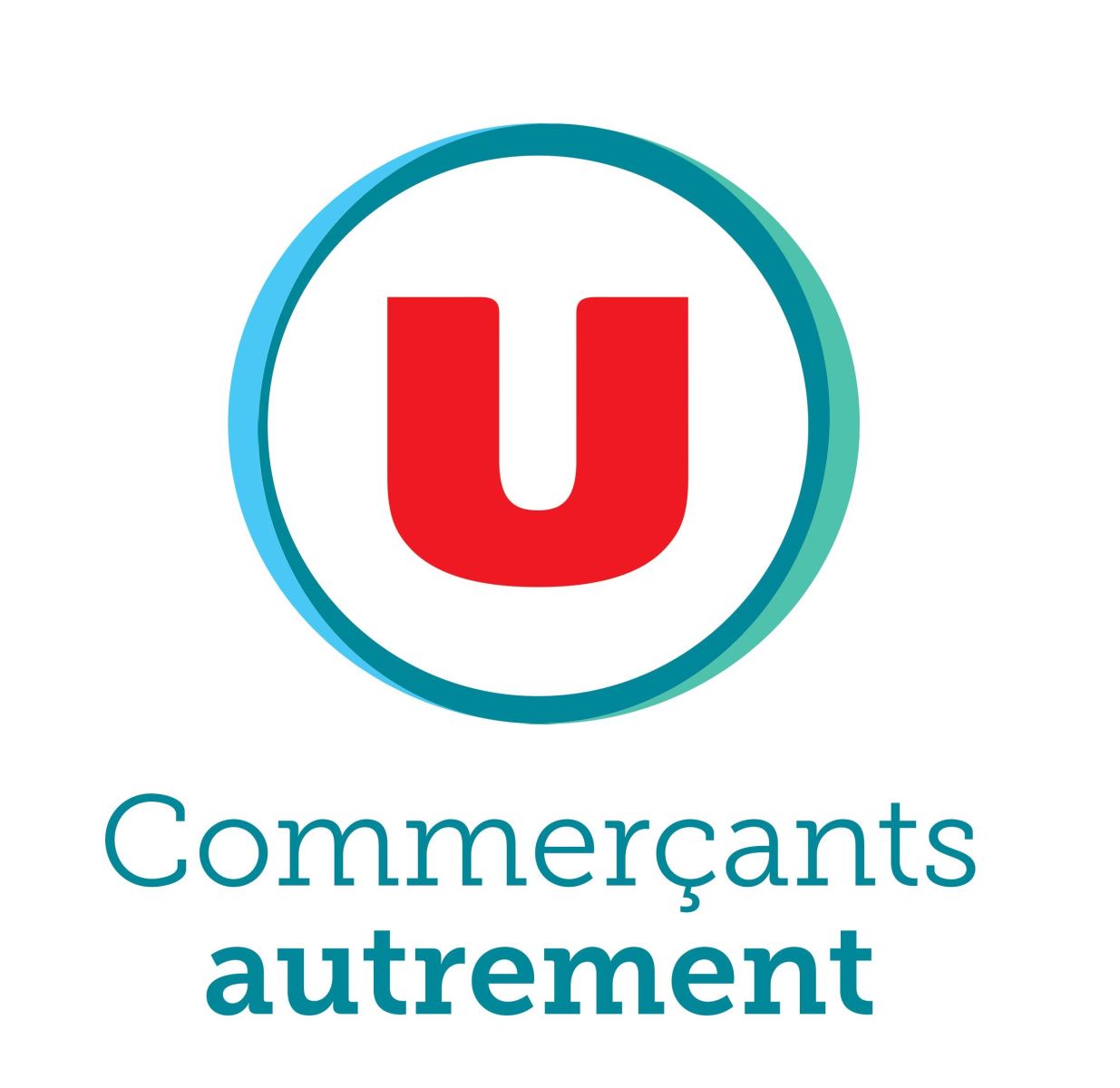

.png)

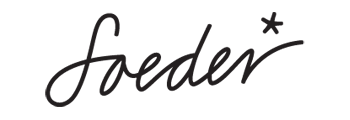
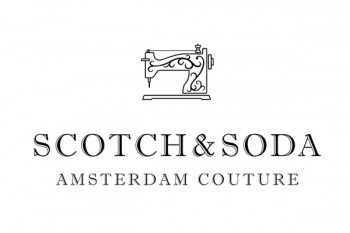
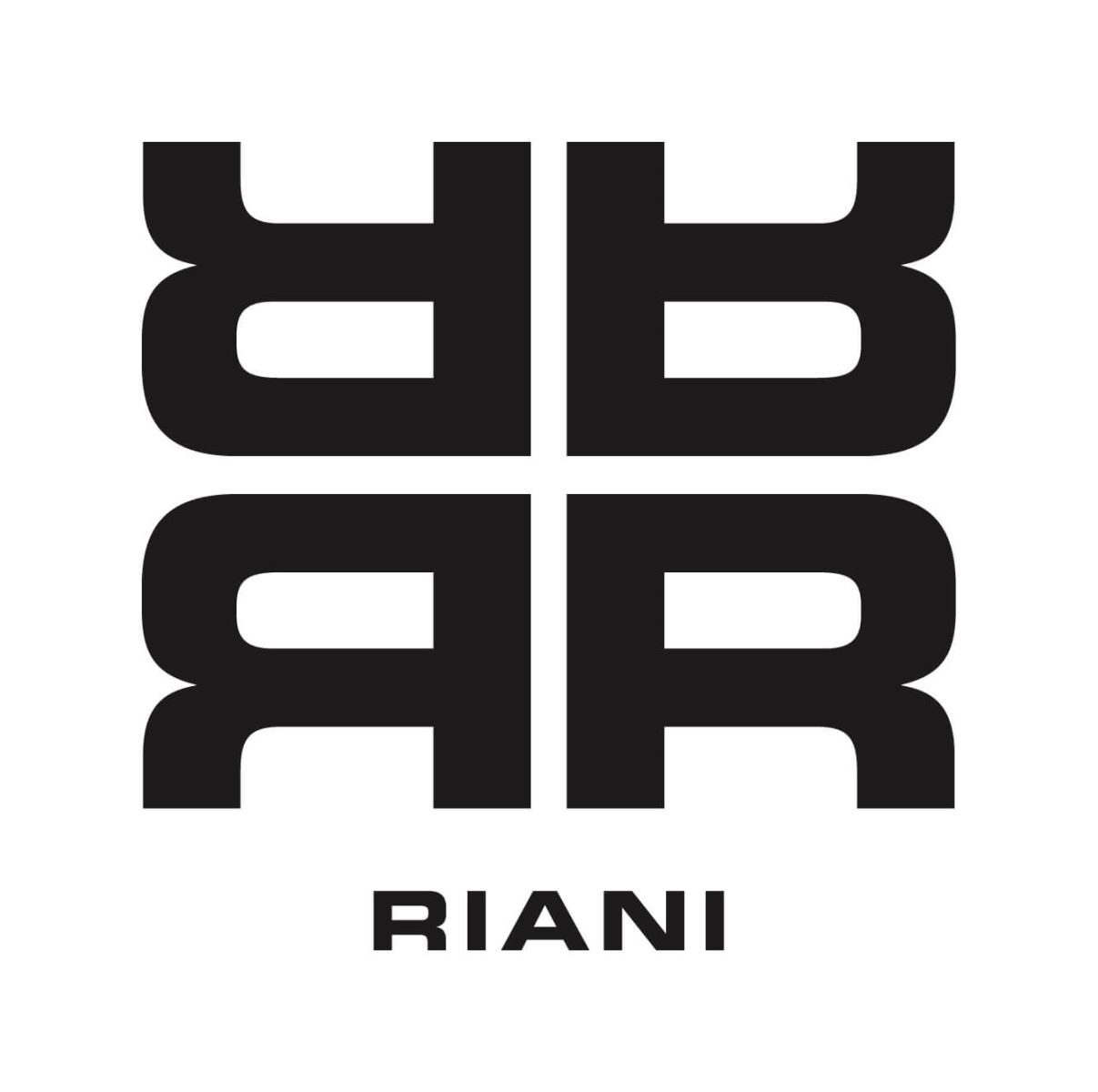

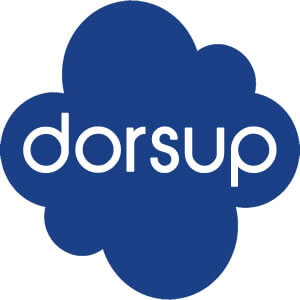
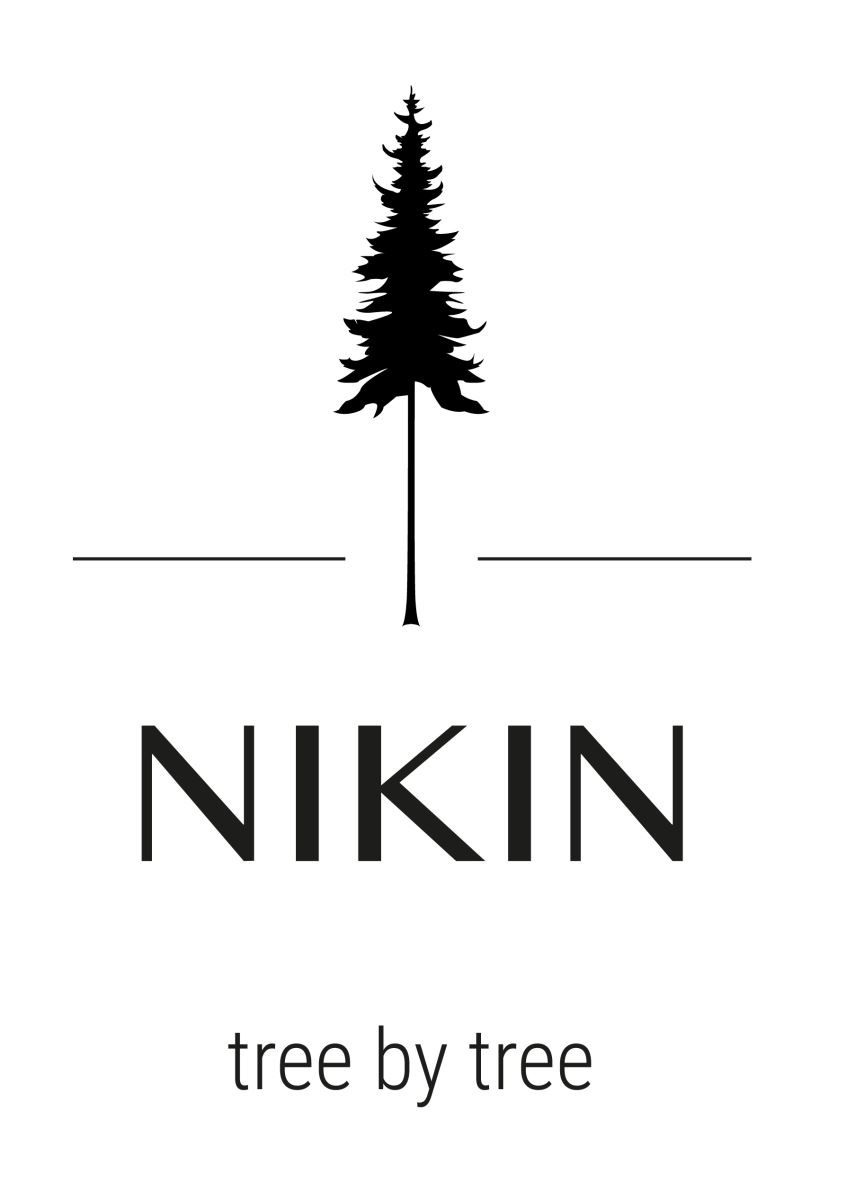
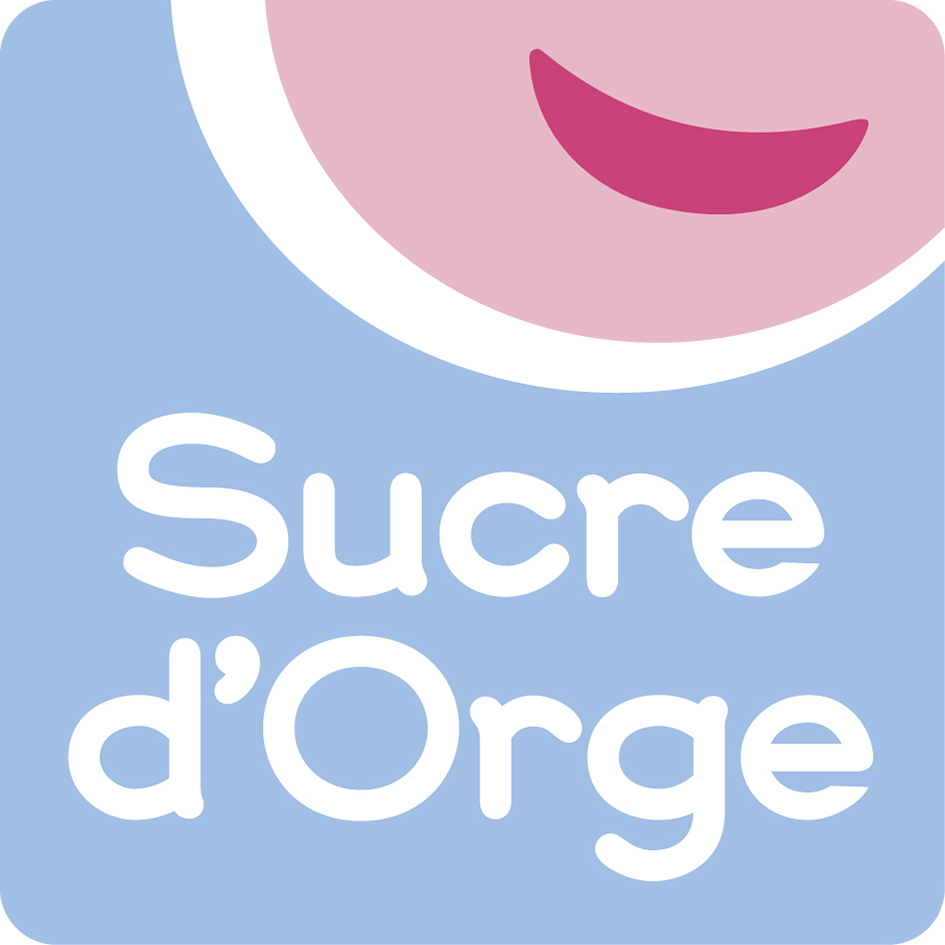
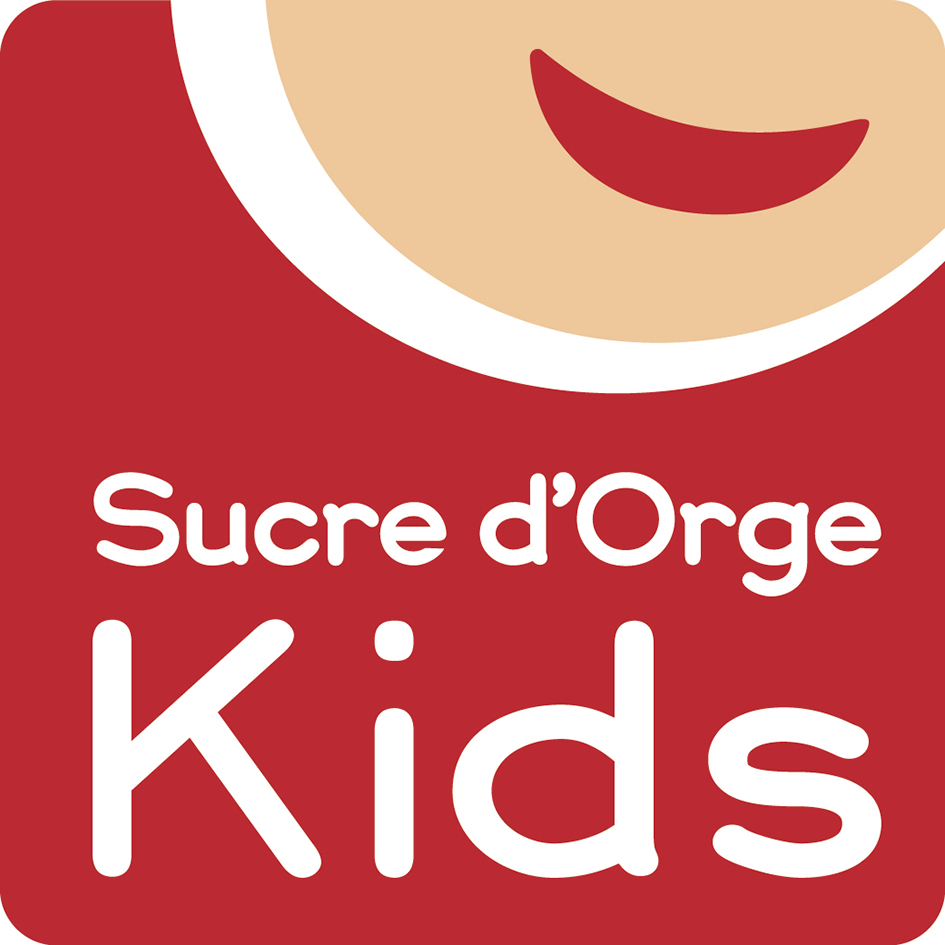
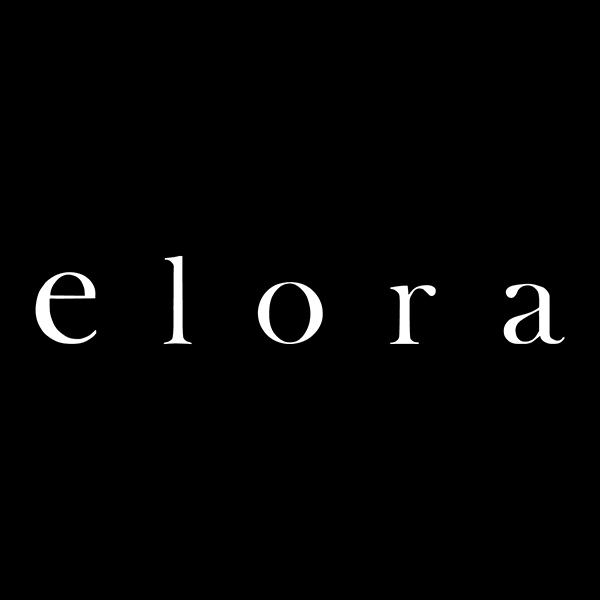
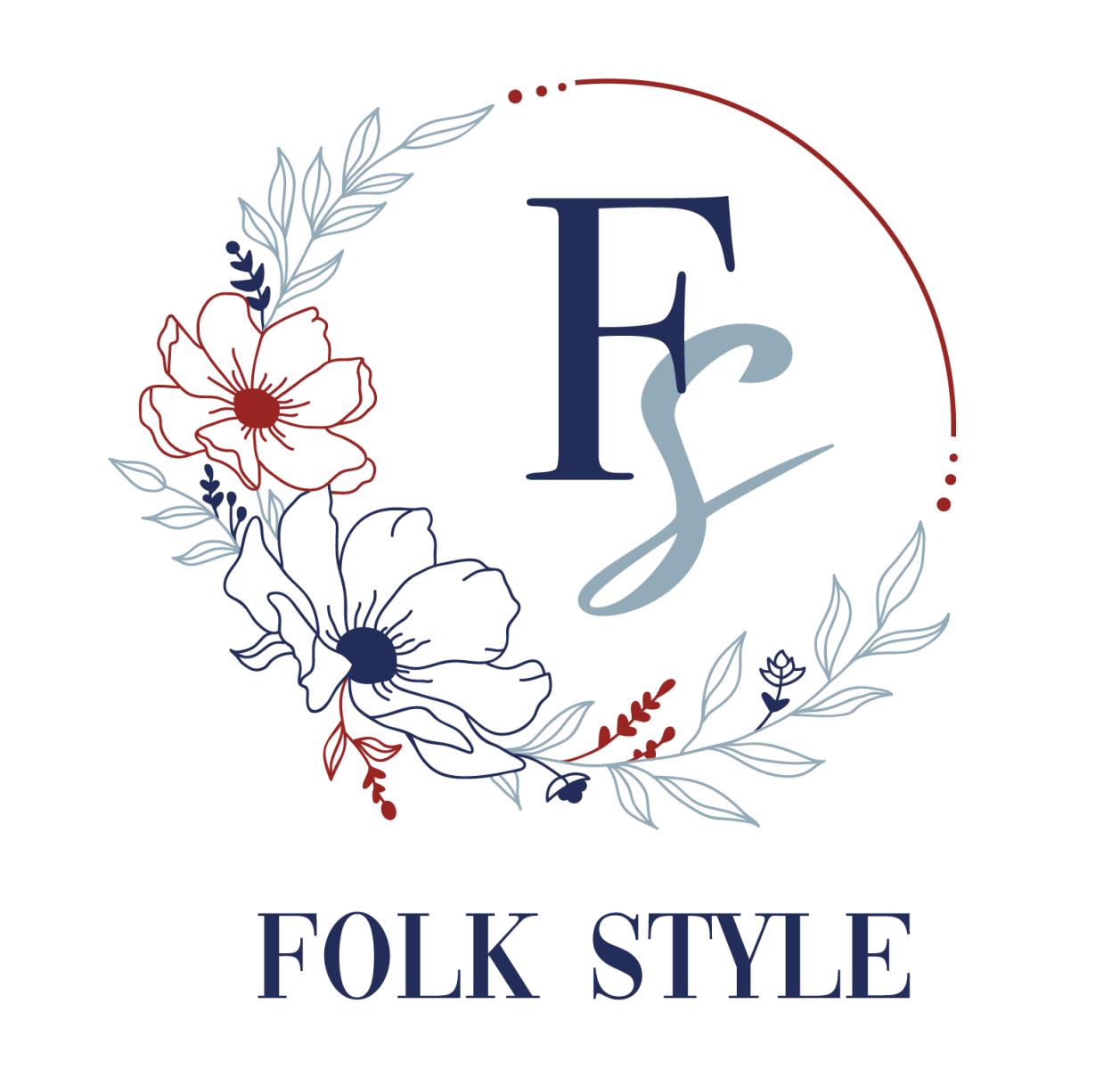

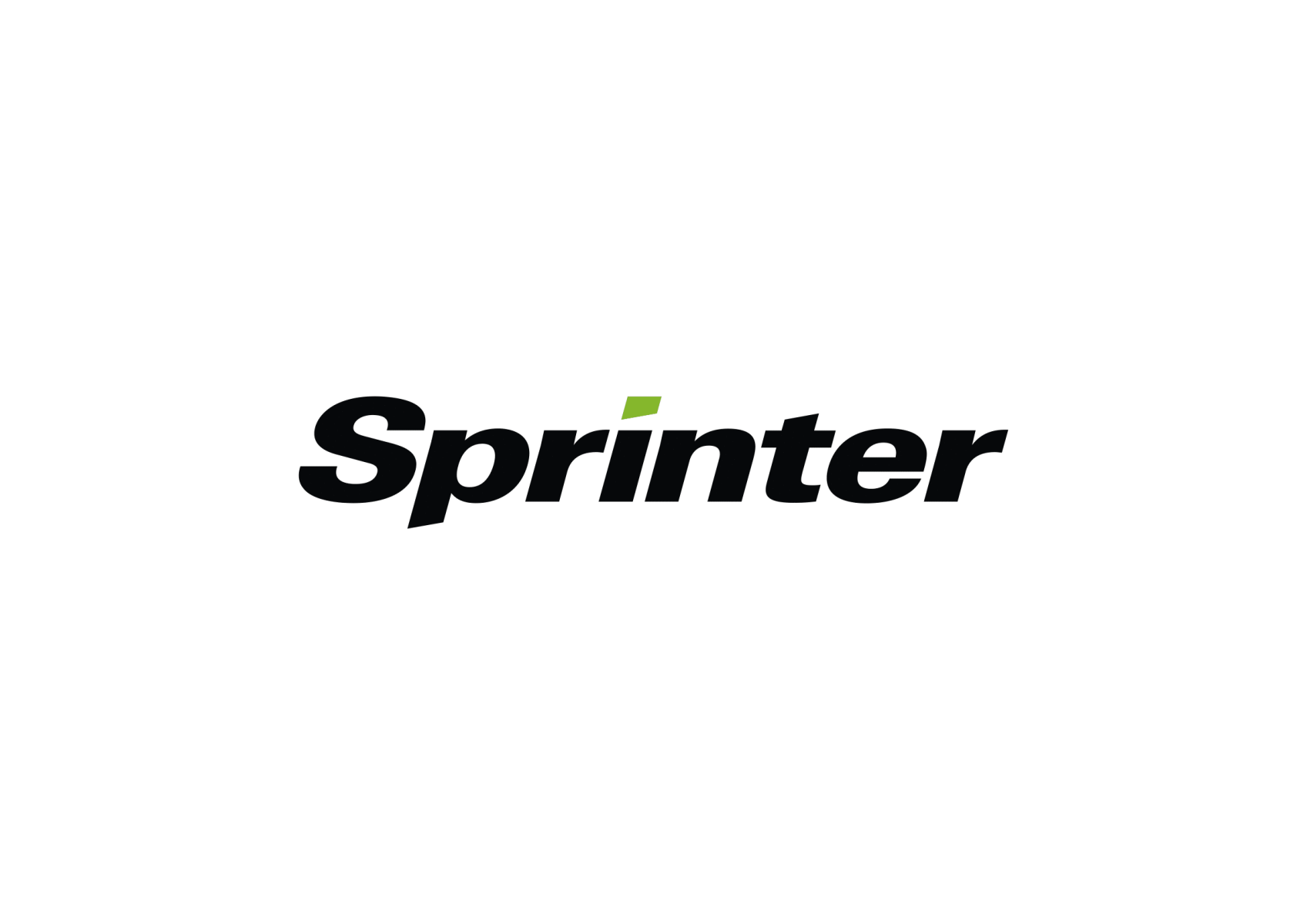

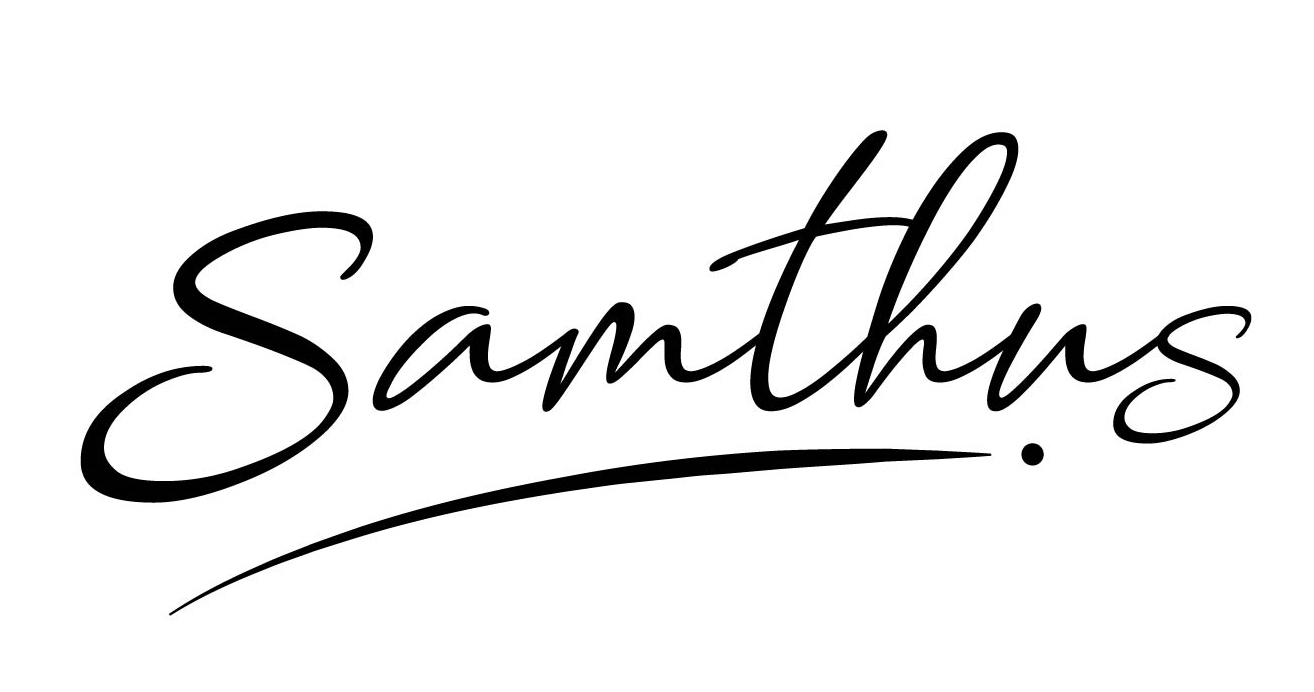
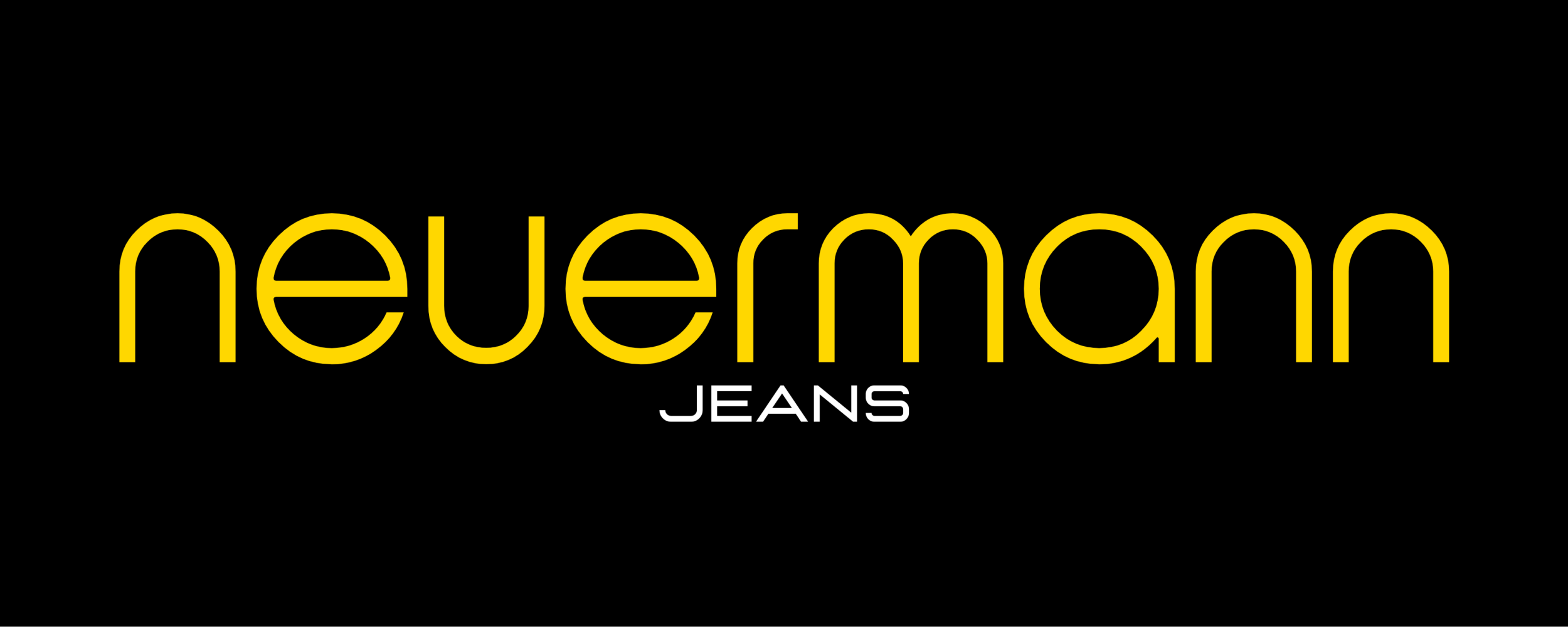
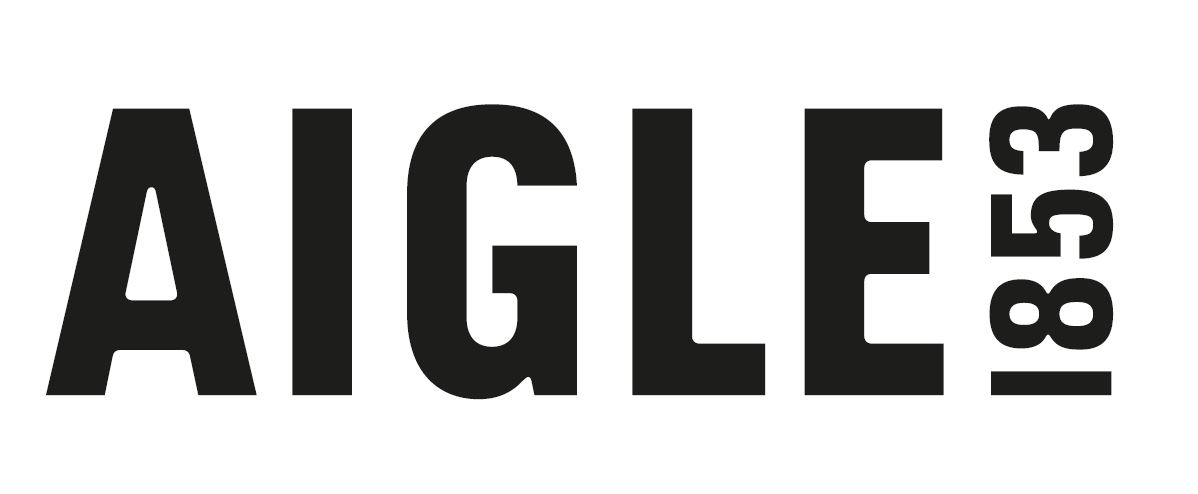
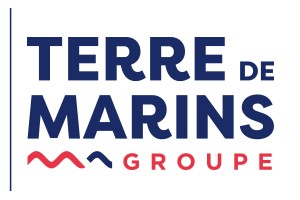

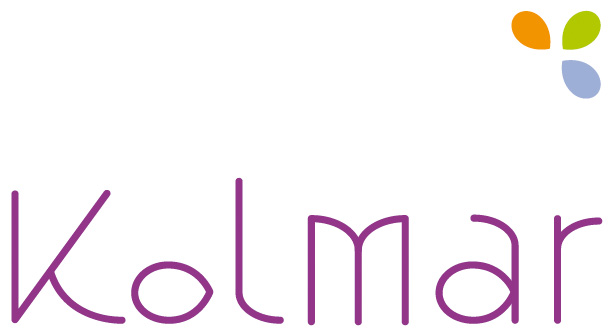


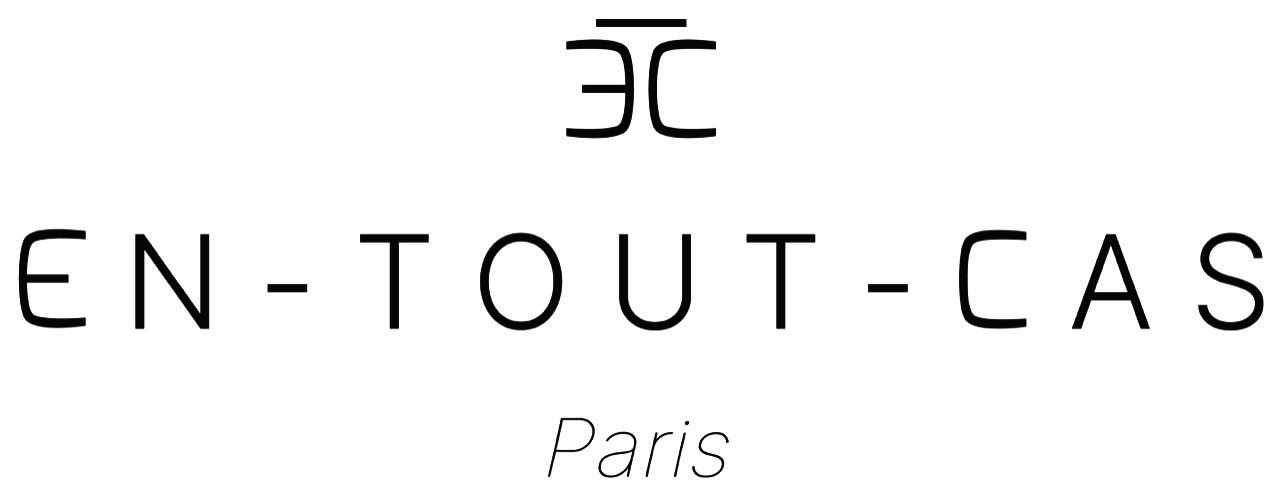
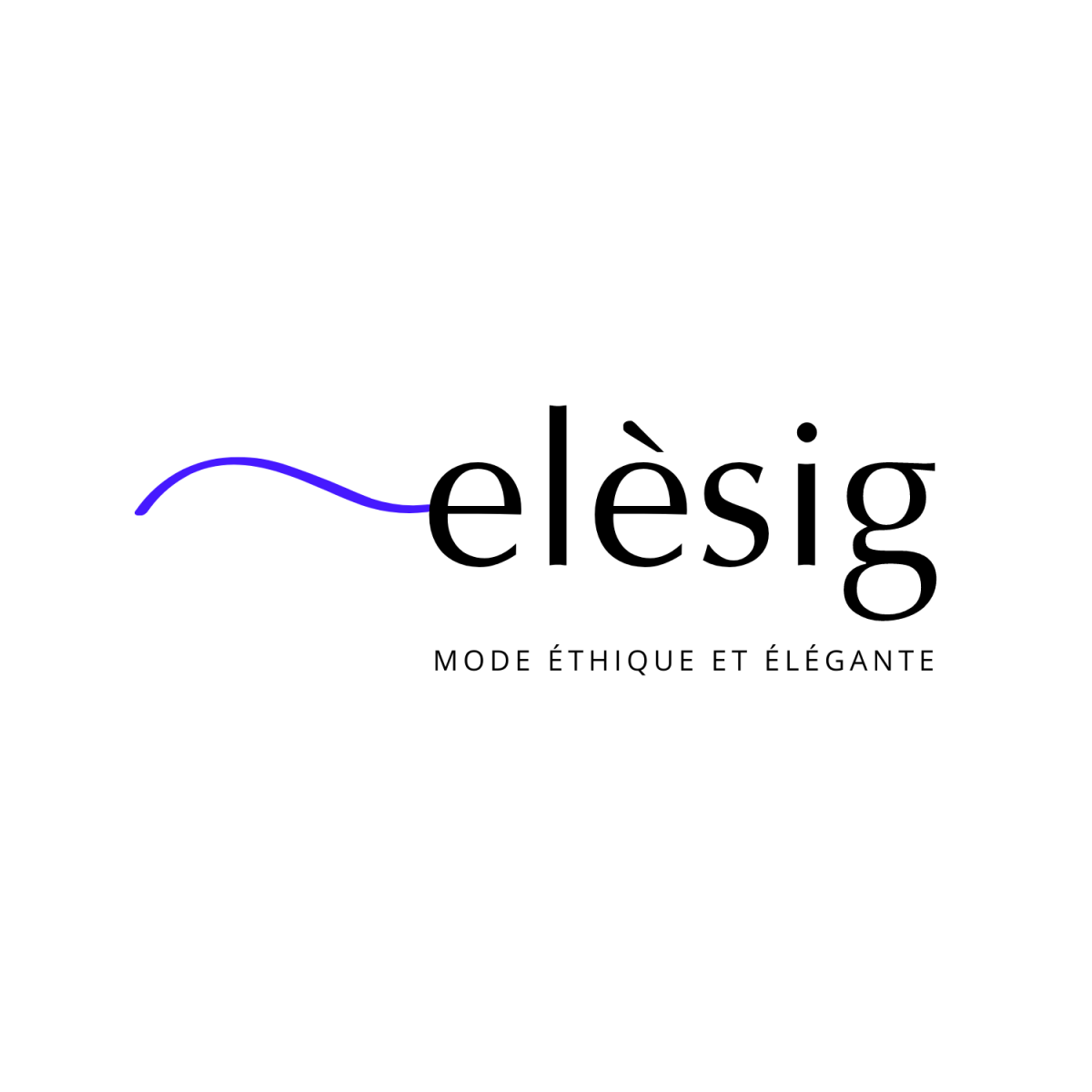

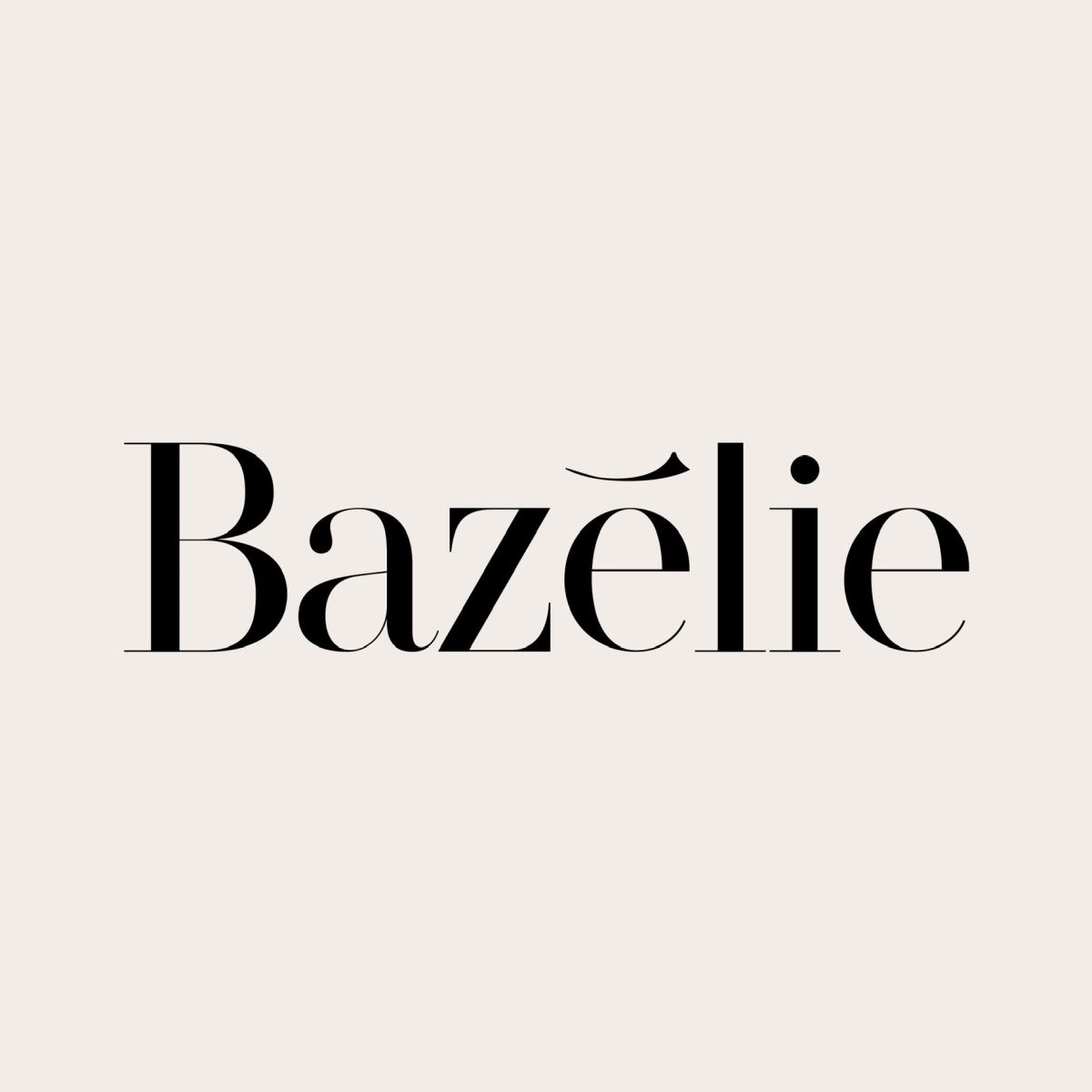

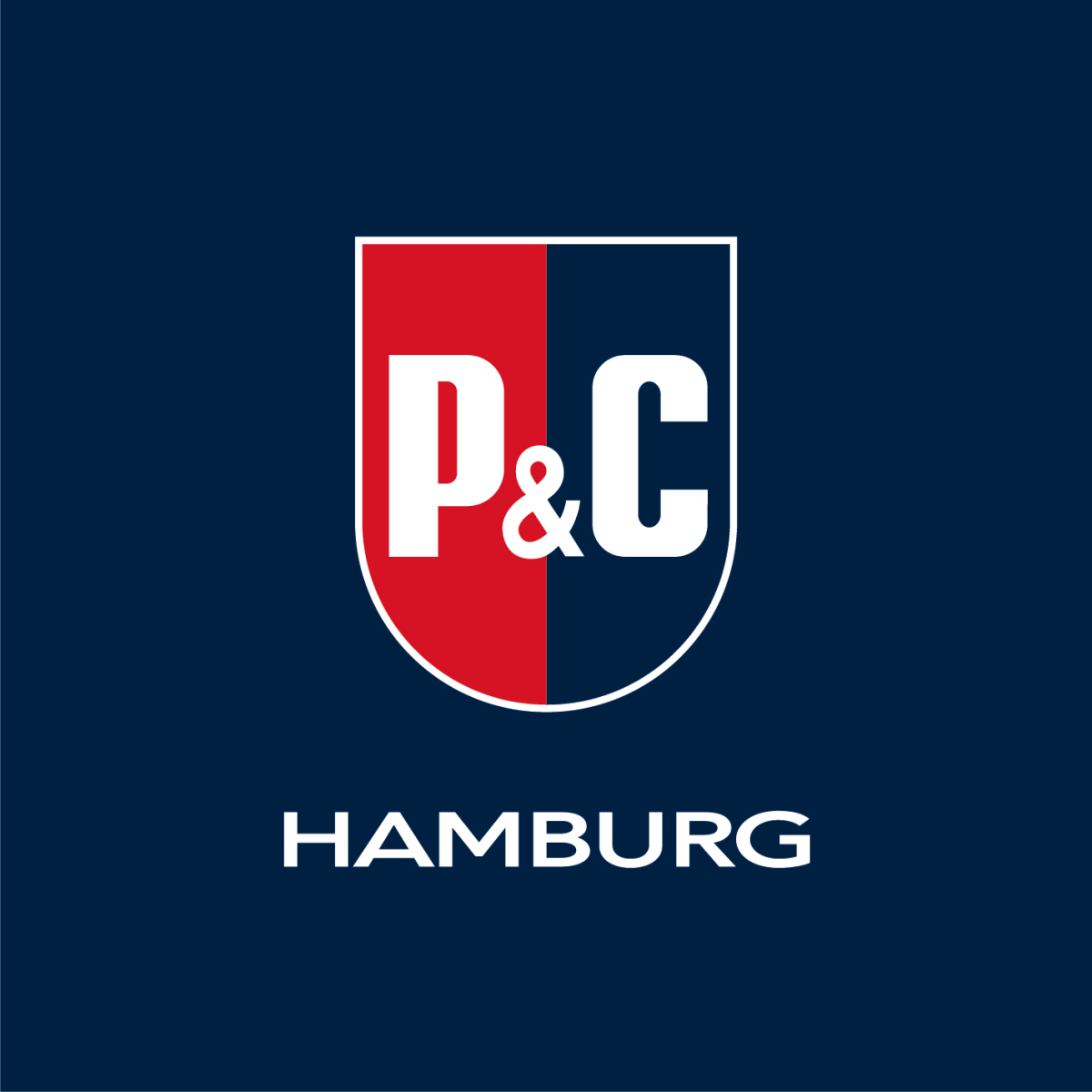

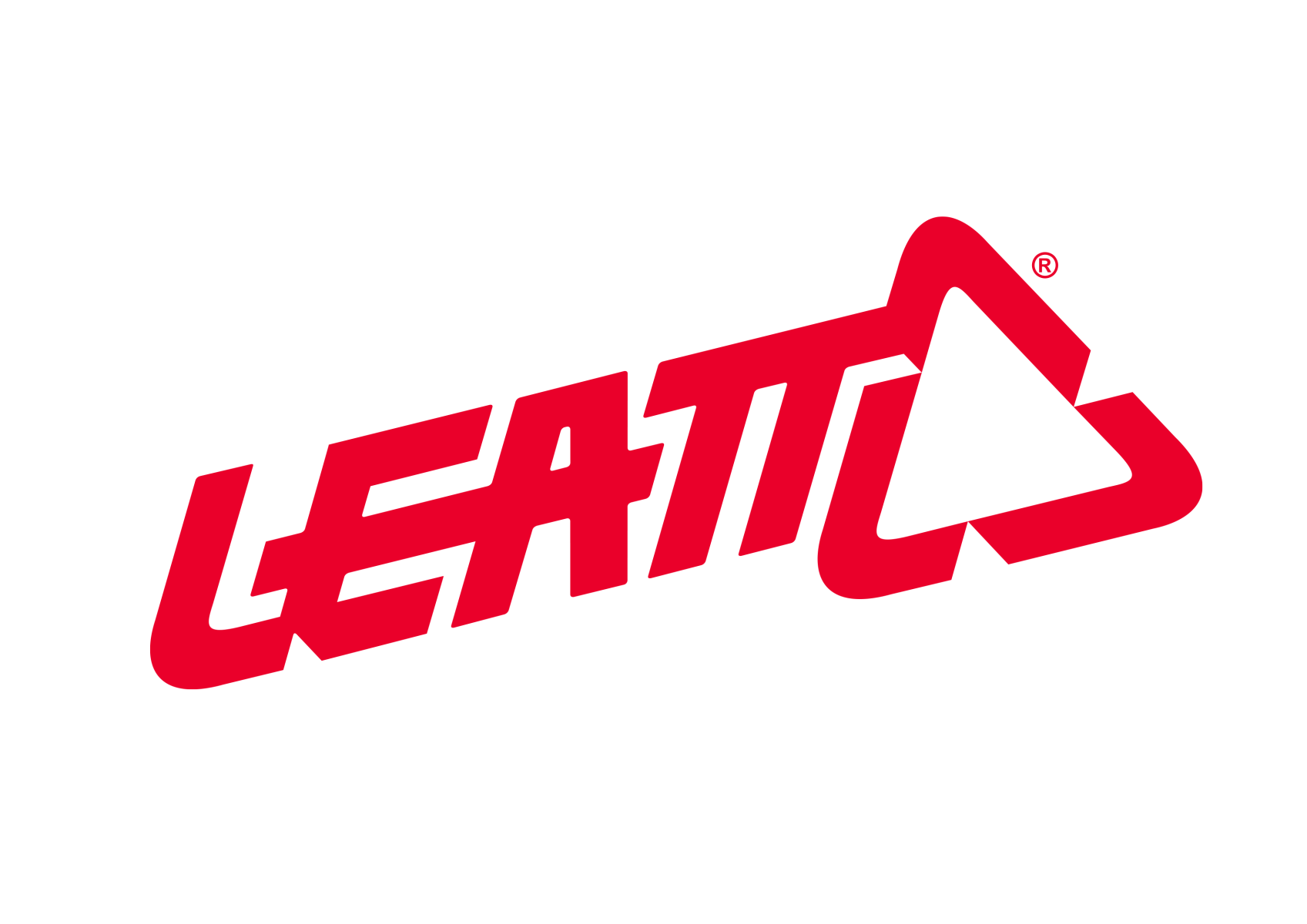

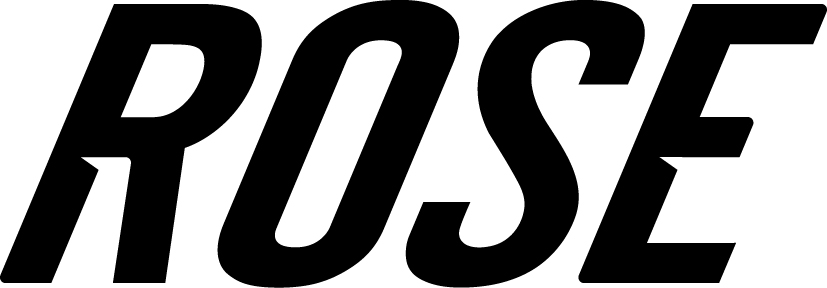
.jpeg)
